The Art of Serenity: My Personal Guide to Choosing the Perfect Art for Above Your Bed
Discover my personal approach to selecting and placing art above your bed. Learn how to create a tranquil, stylish, and deeply personal sanctuary with the right artwork, from scale to style, and avoid common pitfalls.
# The Art of Serenity: My Personal Guide to Choosing the Perfect Art for Above Your Bed
There's a quiet magic about a bedroom, isn't there? It's more than just a place to sleep; it’s the canvas for our deepest rest and our most intimate dreams, the first view we greet with dawn, and the last we bid farewell to each night. For me, it's a deeply personal sanctuary, a space that should embrace you in comfort and inspire gentle, unhurried contemplation. This is precisely why the art you choose here, especially above your bed, plays a surprisingly profound role in setting that tone. It’s not merely decor; it’s a silent dialogue with your subconscious, an extension of your inner world, a gentle affirmation of peace and beauty. It’s truly a practice in mindful living. And the space directly above your bed? That’s prime real estate for setting this intentional tone. It's not just a blank wall waiting to be filled; it's an opportunity to complete the visual story of your most personal haven. Consider this your roadmap to curating that perfect piece, ensuring the art above your bed truly enhances the serenity and aesthetic of your personal sanctuary. Through years of curating art for my own home and for others, I've discovered the immense power this specific space holds. It's the visual anchor that sets the tone for your rest and rejuvenation. And honestly, who doesn't want to wake up feeling inspired and drift off to sleep enveloped in beauty? As an artist who finds deep peace in the creation and contemplation of abstract art, I've come to understand that this isn't just about hanging something pretty; it's about crafting an immersive experience that supports your holistic well-being. This guide distills my years of exploration into practical, soulful advice, making it the ultimate resource for transforming the space above your bed into a true haven.
### Why Art Above Your Bed Matters (More Than You Think)
I know what you're probably thinking: "It's just art on a wall, Zen." But believe me, above your bed, it's so much more. This isn't just a decorative accent; it's a silent guardian, a mood setter, and often, the **focal point** of the entire room. When you walk into your bedroom, your eyes naturally drift towards the bed, and whatever hangs above it will immediately influence the feeling of the space. It can soothe, inspire, or, if chosen poorly, even agitate. We definitely don't want the last one, do we? From a psychological perspective, the visual stimuli we encounter right before sleep and upon waking significantly impact our mood and even our sleep quality. Studies in environmental psychology, particularly the fascinating field of **neuroaesthetics** (the study of how art affects the brain), increasingly highlight how our immediate surroundings profoundly impact our well-being. A carefully chosen piece of art above your bed can significantly contribute to stress reduction, improve mood, and cultivate a profound sense of calm. For instance, research shows that viewing certain types of art can lower cortisol levels and even influence heart rate, guiding your body towards a state of rest. It's a powerful, non-pharmacological tool for enhancing your daily mental state. The science is fascinating, and if you're keen to dive deeper, you might appreciate my thoughts on [the psychology of color in interior design with art](/finder/page/the-psychology-of-color-in-interior-design-with-art).
Beyond the immediate psychological benefits, there's also a historical and cultural resonance to art in the bedroom. For centuries, across various civilizations, the bedroom was not just for sleep but often a private receiving room, a space for personal reflection, and a display of one's personal aesthetic and values. While our modern bedrooms are more exclusively private, the essence of this personal display remains. I love thinking about how, say, a Rococo boudoir's ornate paintings served to delight and soothe, much as our contemporary choices aim to. The evolution of art in interior design is a fascinating journey, and if you're curious how these ideas translate over time, you might enjoy reading about [the evolution of art in interior design: from grand salons to modern minimalism](/finder/page/the-evolution-of-art-in-interior-design-from-grand-salons-to-modern-minimalism).
Think of it: the first thing you see when you open your eyes, the last before you close them. This visual input quite literally sets the tone for your internal state, shaping your mental landscape. For me, this is where the magic happens – transforming a functional space into a true sanctuary. It's not just about looking good; it's about feeling good, creating a personal sacred space that truly nourishes your soul. Think of it as a quiet visual affirmation for your day, both beginning and end, shaping the very first and last impressions you have. This intentionality transforms a bedroom from a mere sleeping area into a profound psychological haven, a subtle yet powerful engine for well-being. It’s a silent conversation with your subconscious, nurturing peace and setting a positive tone for your internal landscape. To illustrate, here’s a quick overview of how the right art can truly elevate your well-being:
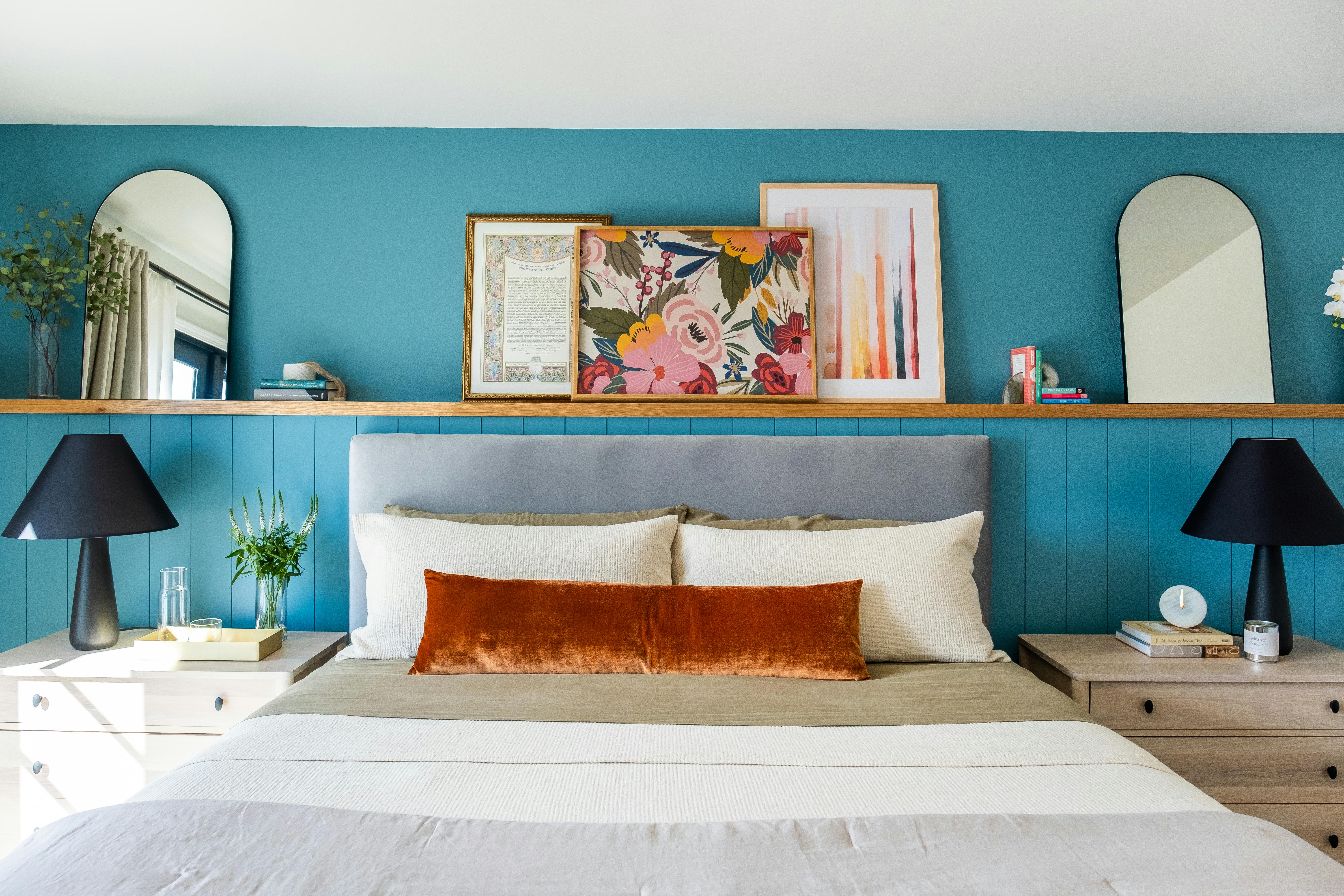
[credit](https://images.pexels.com/photos/17386970/pexels-photo-17386970/free-photo-of-interior-design-of-bedroom.jpeg),
[licence](https://creativecommons.org/public-domain/)
| Psychological Benefit | How Art Contributes |
| :-------------------- | :-------------------------------------------------------- |
| **Stress Reduction** | Calming colors and serene imagery lower cortisol levels. |
| **Improved Mood** | Pleasant aesthetics trigger positive emotional responses. |
| **Enhanced Sleep** | Non-stimulating visuals promote a restful mental state. |
| **Personal Connection** | Art reflecting your taste fosters a sense of belonging. |
| **Mindful Awakening** | A gentle focal point encourages positive morning reflection. |
| **Self-Expression** | Your chosen art reflects your inner world and values. |
For instance, I once saw a bedroom with a huge, incredibly busy abstract piece above the bed – vibrant reds, sharp angles, pure energy. While stunning in a living room, here, it just screamed "wake up!" when all I wanted was "wind down." It was a powerful reminder that context is everything when it comes to art placement.
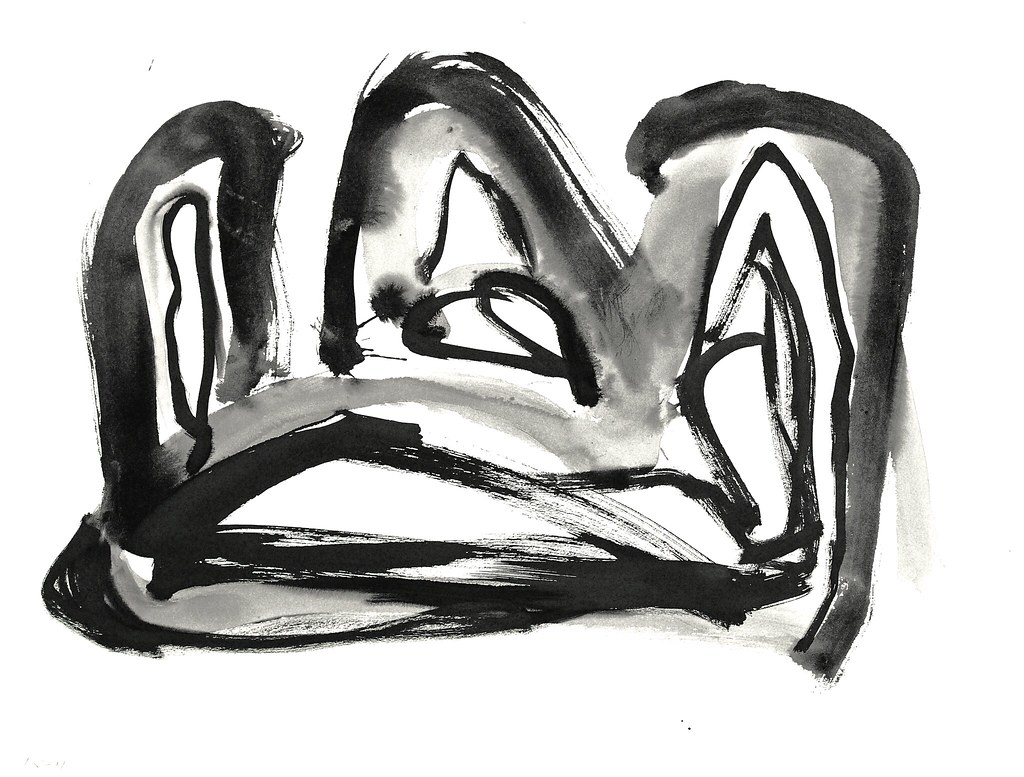
[credit](https://live.staticflickr.com/8106/28584971225_11401ccfde_b.jpg),
[licence](https://creativecommons.org/licenses/by/2.0/)
<br>
It's not just about the art looking 'right'; it's about how it makes the entire room *feel*. When scale and placement are off, the visual disharmony can be surprisingly unsettling, disrupting the very tranquility you're trying to cultivate.
### The Golden Rules of Scale and Placement (My Non-Negotiables)
If there’s one area where I get a bit prescriptive, it's scale and placement. Get this wrong, and even the most beautiful artwork can look out of place. It’s like wearing a hat that’s either two sizes too big or ridiculously small – it just throws everything off.

[credit](https://live.staticflickr.com/2286/1850765168_c032b90730_b.jpg),
[licence](https://creativecommons.org/licenses/by/2.0/)
### Understanding Bed Types and Their Influence
Before we even consider the art itself, it's crucial to understand the foundational element: your bed. Different bed types inherently offer different opportunities and constraints for the art above them.

[credit](https://live.staticflickr.com/1640/24944351291_9f85895834_b.jpg),
[licence](https://creativecommons.org/licenses/by-nc-nd/2.0/)
* **Platform Beds:** Often sleek and low-profile, these beds allow for more vertical wall space above the headboard, inviting taller or more dramatic artwork. Consider a striking vertical abstract or a series of stacked minimalist prints to emphasize the height and sleekness. For these contemporary foundations, I often envision art that echoes their clean lines, perhaps a bold, singular abstract piece that draws the eye upward without overwhelming the simplicity below.
* **Canopy Beds:** While beautiful, a canopy bed already creates a significant architectural statement. Here, subtle art, perhaps a diptych or triptych that complements the canopy's lines, works best. You don't want the art battling the bed for attention; instead, aim for art that offers a quiet visual echo of the bed's elegance. A series of small, unframed botanical prints, for instance, could soften the grandeur without competing.
* **Sleigh Beds:** With their typically high, curved headboards, sleigh beds require art that either sits significantly above the curve or integrates seamlessly with it, often leaning towards wider, more horizontal pieces. Think expansive landscapes or fluid abstracts that flow with the headboard's graceful lines. The sweeping curves of a sleigh bed can be beautifully complemented by a wide, calm seascape, extending the feeling of tranquil motion.
* **Divan Beds (No Headboard):** This offers the most flexibility, allowing you to create your own "headboard" effect with art. You can go larger, lower, or even a full gallery wall, as the bed itself provides minimal visual interruption. This is your chance to really experiment with scale and composition to define the bed's presence. I love the freedom a divan bed offers; it's a blank canvas for the art to truly define the space, allowing for anything from an oversized abstract focal point to a carefully curated, serene gallery wall.
Understanding your bed's inherent design is the first step in creating a harmonious display. By working *with* your bed's form, rather than against it, you ensure the art feels like a natural extension of the room's most important furniture piece. To give you a clearer idea, here's a quick guide to how different bed types influence your art choices:
| Bed Type | Description | Art Placement Considerations |
| :--------------- | :--------------------------------------------- | :------------------------------------------------------------------------------------------------------------- |
| **Platform Beds** | Sleek, low-profile, often with a simple headboard. | More vertical wall space, allowing for taller or more dramatic single pieces, or a vertically stacked diptych. |
| **Canopy Beds** | Creates a significant architectural statement. | Subtle art (diptych/triptych) that complements canopy lines. Avoid art that competes or feels too busy. |
| **Sleigh Beds** | High, curved headboards. | Art should sit significantly above the curve or integrate seamlessly. Wider, horizontal pieces often work best. |
| **Divan Beds** | No headboard, offering maximum flexibility. | Opportunity to create a "headboard effect" with art. Go larger, lower, or even a full gallery wall. |
| **Adjustable Beds** | Modern, often with built-in headboards or no headboard. | Consider how the bed's movement impacts the viewing angle; ensure art is securely mounted and positioned flexibly. |
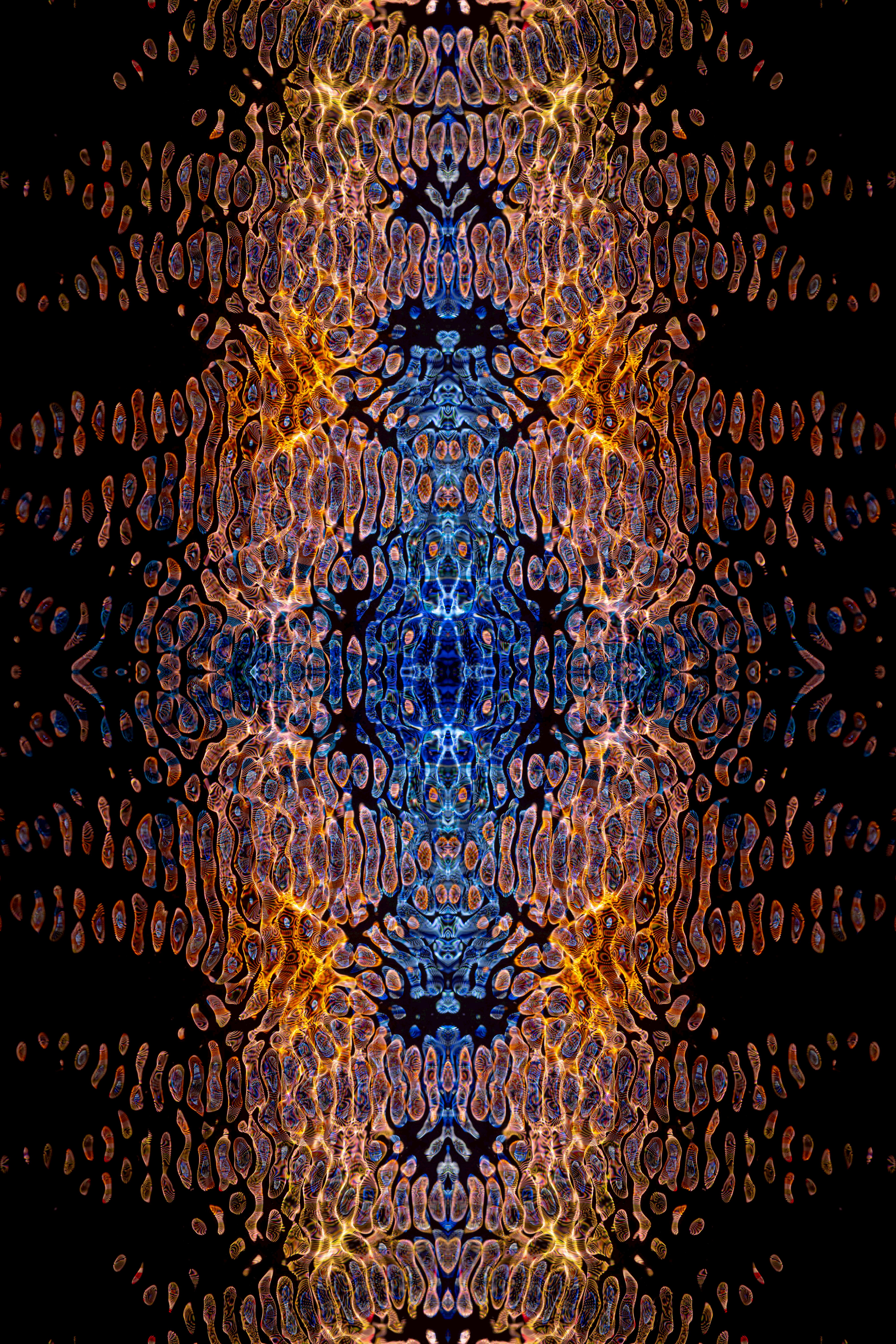
[credit](https://images.pexels.com/photos/10996828/pexels-photo-10996828.jpeg),
[licence](https://creativecommons.org/public-domain/)
### Considering Your Headboard: An Integral Part of the Canvas
Before we dive into the numbers, let's talk headboards. I often see people treat the space above the bed as a separate entity from the headboard itself, but I think of them as a unified composition. Your headboard isn't just a functional piece; it's a foundational element of your bedroom's visual story. Whether it's a plush upholstered statement piece, a minimalist wooden panel, a rustic reclaimed wood design, or even an architectural feature of the wall itself (like wainscoting or a built-in niche), its presence dictates the starting point for your art. Think about its height, its material, its texture, and its visual weight. A very tall, imposing headboard might mean you need a piece of art that's higher or larger in scale to avoid looking dwarfed, or perhaps a horizontal piece that accentuates its width. Conversely, a low, sleek headboard offers more vertical real estate for dramatic compositions, allowing the art to take center stage. The goal is always a cohesive flow, never a battle for attention – the art and headboard should feel like they were made for each other. It's a delicate dance, really, where each partner enhances the other, creating a unified and visually pleasing focal point. For instance, a deeply tufted velvet headboard might perfectly frame a soft, minimalist abstract, creating a luxurious textural interplay. And if your headboard is a vintage find or a custom creation, consider how the art can echo its unique charm without overpowering it, creating a truly bespoke feel. The interplay of materials is also key – a smooth metal headboard might beautifully contrast with a textured abstract, while a rustic wooden headboard could be complemented by a soft, ethereal landscape. A cane or rattan headboard, for instance, pairs wonderfully with organic, naturalistic art, reinforcing a calm, earthy vibe. It’s about creating a visual conversation, a delicate balance that makes both elements shine. Consider a sumptuous velvet headboard; it might perfectly frame a soft, minimalist abstract, creating a luxurious textural interplay. Or for a vintage iron headboard, a delicate line drawing or a muted botanical print could echo its intricate details without competing, enhancing the antique charm rather than overpowering it. It’s about letting the headboard and art speak to each other, creating a unified narrative for your sleep sanctuary.
#### 1. Size Matters (Seriously, It Does)
This is the biggest mistake I see people make: hanging art that’s too small. A tiny piece above a large bed looks lost, like a whisper in a storm. For a single piece of art, aim for it to be **two-thirds to three-quarters the width of your bed or headboard**. So, if your queen bed (typically 60 inches wide) suggests art between 40 and 45 inches, a king-sized bed (76 inches wide) would call for a piece in the 50-57 inch range. Even a twin bed (38 inches wide) benefits from a piece around 25-28 inches. This creates a balanced, intentional look, preventing the art from looking like an afterthought. If your headboard is particularly tall, you might opt for a piece slightly smaller in width but taller in stature to complement its lines. Conversely, a very low headboard allows for a wider, more expansive artwork. If you're struggling with sizing for various rooms, my guide on [choosing art for your living room](/finder/page/choosing-art-for-your-living-room) has some universally applicable wisdom. For smaller bedrooms, don't despair! [Abstract art for small spaces: maximizing impact in compact areas](/finder/page/abstract-art-for-small-spaces:-maximizing-impact-in-compact-areas) offers strategies for making a statement without overwhelming the room. You might also find valuable insights in [maximizing impact: choosing art for high ceilings](/finder/page/maximizing-impact-choosing-art-for-high-ceilings), depending on your unique space.
If you're considering a larger piece, say, one that spans almost the entire width, that can work too! It makes a bold statement and can really ground the bed, turning it into an undeniable design anchor. To make things a little easier, here's a quick reference table:

[credit](https://www.publicdomainpictures.net/pictures/280000/nahled/copyright-symbol-c.jpg),
[licence](https://creativecommons.org/publicdomain/zero/1.0/)
| Bed Size | Typical Width (Inches) | Recommended Art Width (Inches) | Equivalent Width (cm) |
| :-------------- | :--------------------- | :----------------------------- | :-------------------- |
| Twin | 38 | 25 - 28 | 63 - 71 |
| Full | 54 | 36 - 40 | 91 - 102 |
| Queen | 60 | 40 - 45 | 102 - 114 |
| King | 76 | 50 - 57 | 127 - 145 |
| California King | 72 | 48 - 54 | 122 - 137 |
| Super King | 80 | 53 - 60 | 135 - 152 |
Remember, these are guidelines, not strict rules. Your unique headboard and the overall scale of your room will always play a role. For more general advice on sizing, I find this guide on [choosing art for your living room](/finder/page/choosing-art-for-your-living-room) quite helpful, as many of the principles apply across rooms. Also, if you’re looking to make a statement in a larger space, my insights on [art above the sofa: a guide to perfect placement and scale](/finder/page/art-above-the-sofa-a-guide-to-perfect-placement-and-scale) offer transferable principles for commanding visual presence.

credit,
[licence](https://creativecommons.org/public-domain/)
#### 2. The Sweet Spot (Height, Not Too High!)
Just as crucial as width is height. I like to imagine the art is gently floating above the headboard, not clinging to the ceiling. A good rule of thumb I've picked up over the years is to hang the bottom of the artwork **6 to 8 inches above the top of your headboard**. If you don't have a headboard, then consider the mattress height and aim for the center of the piece to be at eye level when standing, then adjust slightly downwards for seated viewing (which, let's face it, is most of what we do in a bedroom!). A little trick I often use is to cut out a paper template of your art piece and tape it to the wall to visualize the exact placement before drilling any holes. This allows you to step back, look from various angles (even lying on the bed, which is crucial!), and adjust until it feels perfectly balanced. It saves a lot of heartache (and spackle!), believe me. Another small tip: consider the visual weight of the art. A very dark or dense piece might need a little more breathing room above the headboard, while a light, airy piece can sit a bit closer without feeling cramped. This article on [the art of display: how to light and position abstract art for maximum impact](/finder/page/the-art-of-display:-how-to-light-and-position-abstract-art-for-maximum-impact) has some excellent visual examples of ideal height and how to achieve that perfect visual harmony. If you have particularly high ceilings, you might find that hanging the art slightly higher than the 6-8 inch rule, but still well below the ceiling, can help fill the vertical space without making the art feel detached from the bed. Conversely, for lower ceilings, sticking to the lower end of the range, or even slightly less if the headboard is very low, will prevent the room from feeling cramped. It's a subtle but powerful difference that elevates the entire aesthetic and emotional feel of your sanctuary, preventing the art from looking like it's floating aimlessly or, worse, about to attack you! For more comprehensive guidance on optimizing art for varied architectural features, consider [maximizing impact: choosing art for high ceilings](/finder/page/maximizing-impact-choosing-art-for-high-ceilings) which offers a broader perspective on vertical placement.
#### 3. Centering is Key (With the Bed, Not the Wall)
This one might seem obvious, but I've been guilty of eyeing up the entire wall and centering the art on that, only to realize later that it looked off-kilter with the bed itself. Always, always **center your art with your bed**, not the entire wall, unless your bed is perfectly centered on the wall. Your bed is the anchor here, remember? I once helped a friend who had a beautifully curated piece, but it was centered to the wall, not her slightly off-center bed. Walking into the room, something just felt *off*, a subtle imbalance that created a restless feeling. The entire room felt lopsided until we made that simple adjustment to align it perfectly with the bed. It's a small detail, often overlooked, that makes a huge difference in visual harmony and overall bedroom zen – a testament to the power of proper placement.

[credit](https://live.staticflickr.com/5149/5593780004_61287a786a_b.jpg),
[licence](https://creativecommons.org/licenses/by-nc/2.0/)
### Picking Your Palette: Mood Over Madness
Now, onto the fun part – what kind of art! The bedroom, for me, is all about serenity. I want to walk in and feel a gentle exhale. This usually means leaning towards **calming colors** and **soft, inviting textures**. Think blues, greens, muted earth tones, and soft pastels. These hues are known to promote tranquility and aid in relaxation, which is exactly what we want in a bedroom. For instance, blues are often associated with peace, stability, and a sense of vastness that can feel incredibly liberating. Greens, on the other hand, connect us to nature, growth, and balance. Soft purples can bring a sense of luxury, creativity, and calm, while muted earth tones ground the space, fostering a feeling of safety and warmth. Beyond the basic hues, understanding **color temperature** – warm tones like gentle reds and soft oranges versus cool tones like blues and greens – is crucial. Warm colors can feel more stimulating, so use them sparingly and in muted forms; cool colors naturally recede and soothe, creating a sense of expansiveness and calm. The lighting in your bedroom will also drastically affect how these colors are perceived, making a soft, diffused light ideal for maintaining that desired tranquility. A subtle change in your light bulb's warmth can completely shift the perceived mood of a piece, so experiment! You might want to dive deeper into [the psychology of color in abstract art](/finder/page/the-psychology-of-color-in-abstract-art-beyond-basic-hues) to truly understand the impact different shades can have, and even [how artists use color](/finder/page/how-artists-use-color) to evoke specific emotions and influence our mood on a subconscious level. This is where my own abstract pieces, with their often serene and contemplative qualities, really shine. To help you navigate, here’s a little guide to bedroom-friendly color palettes:
| Color Family | Mood Evoked (Bedroom-Friendly) | Considerations |
| :-------------- | :---------------------------------------- | :--------------------------------------------------------------------- |
| **Blues** | Peace, tranquility, stability, calm. | Avoid overly vibrant blues; stick to muted or deep shades. |
| **Greens** | Nature, balance, renewal, harmony. | Earthy greens, sage, or forest greens work beautifully. |
| **Purples** | Luxury, creativity, spirituality, calm. | Soft lavenders or deep indigos are ideal; avoid bright purples. |
| **Earth Tones** | Grounding, warmth, comfort, natural. | Beiges, browns, terracotta, and muted golds create a cozy feel. |
| **Soft Pinks** | Gentleness, comfort, subtle romance. | Dusty rose or blush tones add warmth without being overpowering. |
| **Neutrals** | Serenity, sophistication, versatility. | Greys, creams, whites provide a clean, peaceful backdrop. |
| **Warm Neutrals** | Cozy, inviting, soft sophistication. | Cream, oatmeal, muted gold, and light taupe offer subtle warmth. |
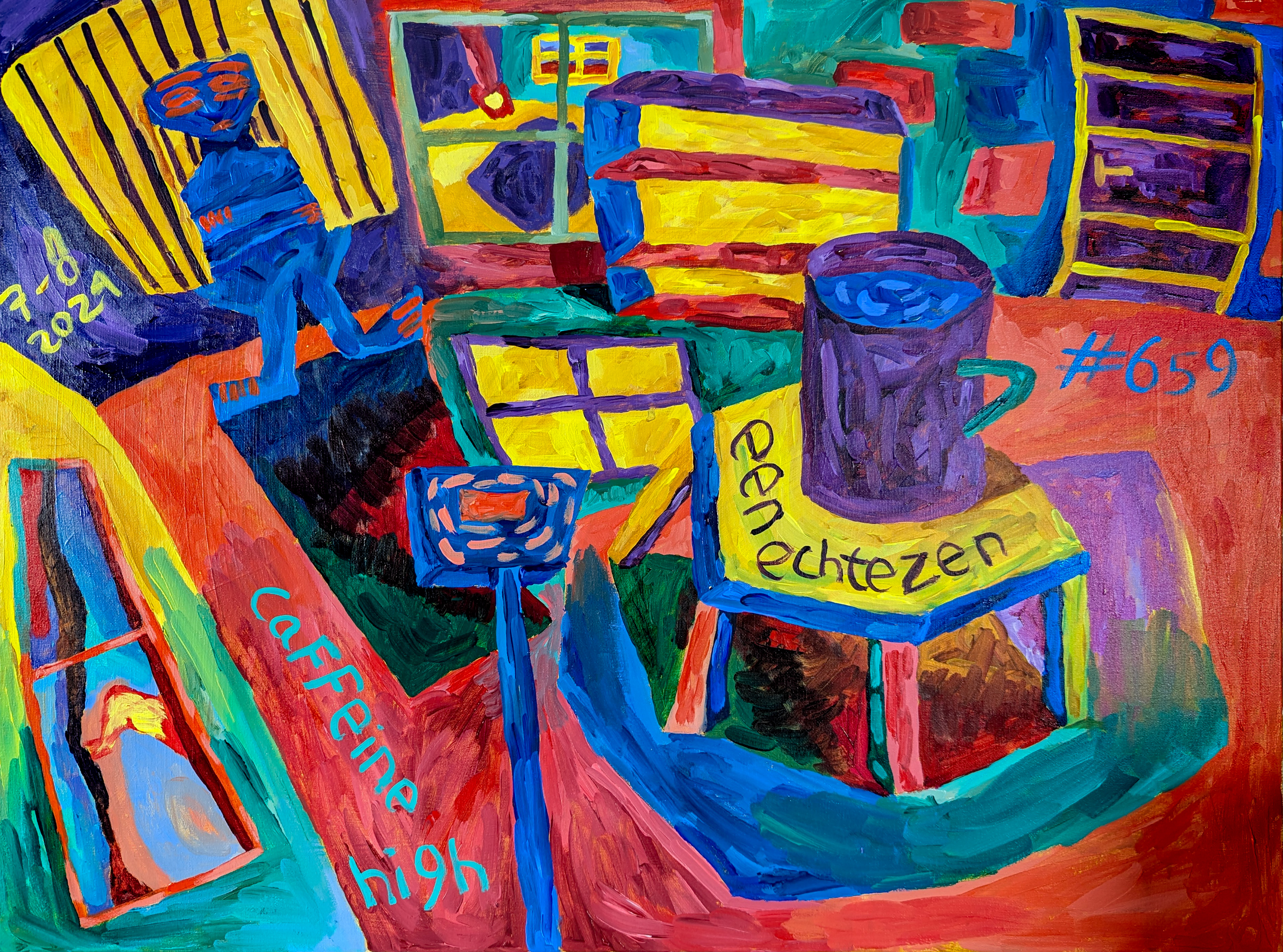
For example, a piece like this abstract with green-blue, purple, and red tones, could evoke a sense of thoughtful calm through its fluid movement and harmonious blending, despite some warmer accents:
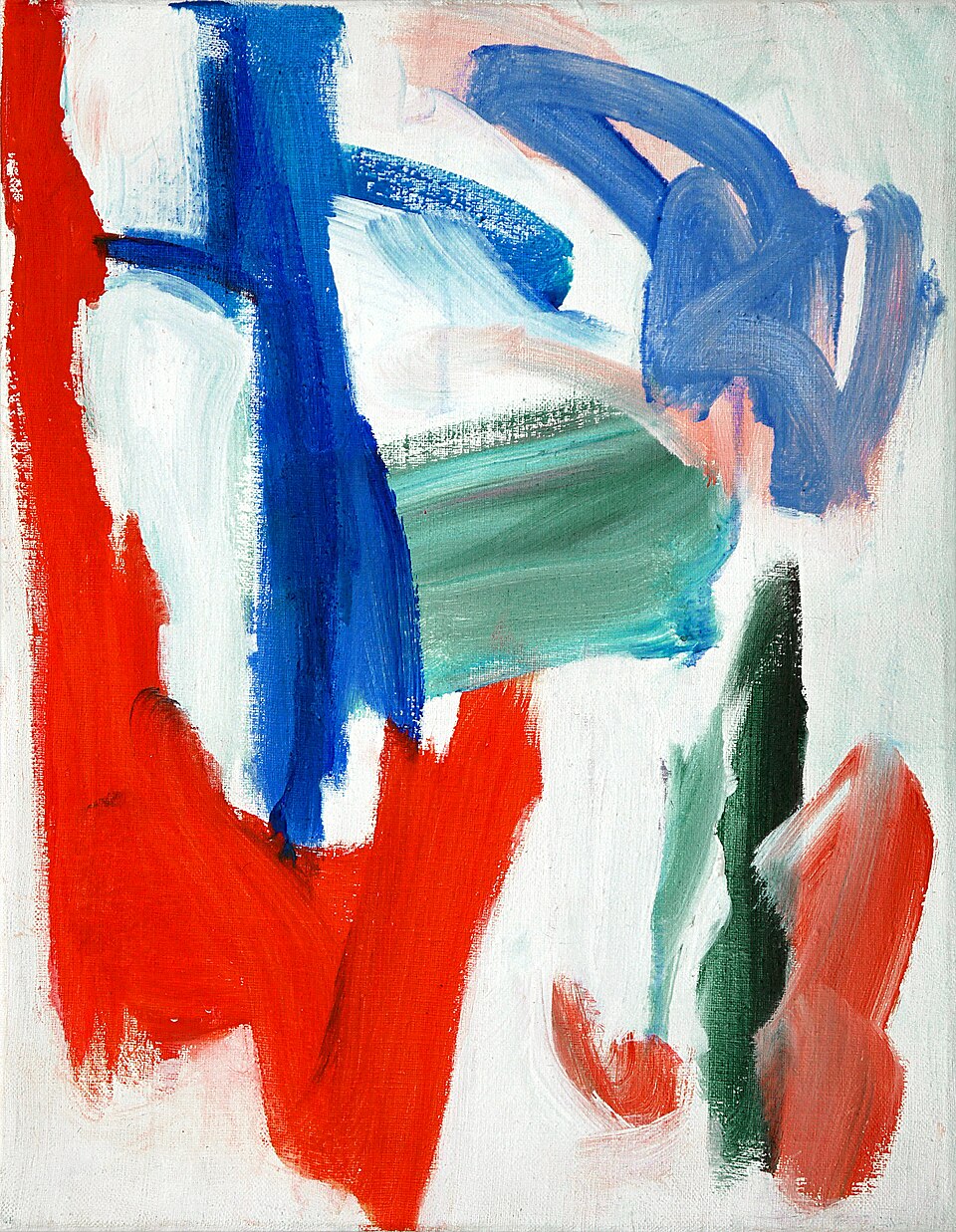
[credit](https://commons.wikimedia.org/wiki/File:%27Abstract_sky%27,_1993_-_small_acrylic_painting_by_Dutch_artist_Fons_Heijnsbroek;_free_download_abstract_art_image,_CCO.jpg), [licence](http://creativecommons.org/publicdomain/zero/1.0/deed.en)
I tend to shy away from anything too jarring or visually aggressive above the bed. Save the bold, high-contrast, high-energy pieces for the living room or an entryway! That's not to say you can't have impact – you absolutely can, but perhaps through subtlety and depth, rather than outright loudness. If you're into minimalist interiors, which naturally lend themselves to a calm bedroom vibe, check out my thoughts on [art for minimalist interiors: less is more](/finder/page/art-for-minimalist-interiors-less-is-more) and [decorating with abstract art in a minimalist living room: creating impact with simplicity](/finder/page/decorating-with-abstract-art-in-a-minimalist-living-room-creating-impact-with-simplicity).
### The Role of Texture in Bedroom Art
Texture is an often-overlooked element in art selection, but its power in a bedroom cannot be overstated. Just as a plush rug or soft linen bedding adds tactile comfort, a textured artwork introduces a visual richness that invites quiet contemplation and sensory engagement. Think of the subtle ridges of an impasto painting, the delicate fibers of a woven tapestry, or the nuanced layers of a mixed media piece. These tactile qualities absorb light differently, create interesting shadows, and add a palpable sense of depth and warmth to a space. In a bedroom, where tranquility is key, texture can soften the overall aesthetic and even contribute to sound absorption, making the room feel more cocooning. A piece with natural, organic textures can further enhance a connection to the natural world, fostering a deeper sense of peace. For a deeper dive into incorporating texture, you might enjoy [exploring texture: my favorite techniques for adding depth to abstract paintings](/finder/page/exploring-texture:-my-favorite-techniques-for-adding-depth-to-abstract-paintings), as many principles apply to appreciating the tactile qualities of textile art.
### Style: What Whispers "Good Night" to You?
Beyond color, the style of the art itself speaks volumes. This is where personal taste truly comes into play. What makes *you* feel at ease? What sparks joy or peaceful reflection?

[credit](https://images.pexels.com/photos/24390314/pexels-photo-24390314/free-photo-of-artist-painting-at-park.jpeg),
[licence](https://creativecommons.org/public-domain/)
* **Abstract Art:** My personal favorite, of course! Abstract art, especially pieces with organic forms, fluid lines, or soft, diffused brushstrokes, can be incredibly soothing. They don't demand a specific interpretation, allowing your mind to wander, to reflect, or simply to rest without focusing on a literal narrative. This makes them perfect for winding down and drifting off to sleep. Think of atmospheric abstractions that evoke a sense of open space, subtle color fields that wash over you with gentle hues, minimalist geometric patterns that offer quiet order, or even expressive abstract expressionist pieces rendered in calming palettes – all can contribute to a profoundly serene environment. It’s like a visual lullaby for your brain, inviting introspection rather than analysis. If you want to delve deeper into the world of non-representational art, I've shared many of my thoughts on [how to understand abstract art](/finder/page/the-definitive-guide-to-understanding-abstract-art-styles) which might spark some inspiration. For a broader understanding of its origins and evolution, take a look at [the definitive guide to the history of abstract art](/finder/page/the-definitive-guide-to-the-history-of-abstract-art-key-movements-artists-and-evolution). Many of my own pieces, which you can browse if you're looking for something unique at [/buy](/buy), are designed to evoke such feelings.
#### Minimalist Art: Simplicity for Serenity
For those who find peace in uncluttered spaces and clean lines, **minimalist art** can be an exceptional choice for the bedroom. This style, characterized by simplicity, subtlety, and often a focus on form, color, and texture, reduces visual noise and invites quiet contemplation. Think of Agnes Martin's serene grid paintings or artists who explore the essence of white, creating depth and presence through absence. Minimalist art doesn't demand attention; it quietly suggests it, allowing your mind to rest rather than analyze. It's about finding profound meaning in subtle expressions and the purity of form. If this resonates with you, I encourage you to delve into the work of artists like Agnes Martin, whose approach to art was deeply spiritual, and explore pages such as [ultimate guide to Agnes Martin: minimalism, grids, and the pursuit of perfection](/finder/page/ultimate-guide-to-agnes-martin-minimalism-grids-and-the-pursuit-of-perfection) or [the serenity of white: my exploration of absence and presence in abstract art](/finder/page/the-serenity-of-white-my-exploration-of-absence-and-presence-in-abstract-art). For a more detailed exploration of different non-representational styles, check out [the ultimate guide to abstract art movements](/finder/page/the-ultimate-guide-to-abstract-art-movements-from-early-pioneers-to-contemporary-trends).

[credit](https://freerangestock.com/photos/152787/a-colorful-graffiti-on-a-building.html),
[licence](https://creativecommons.org/publicdomain/zero/1.0/)
* **Landscapes & Nature:** Imagine waking up to a serene landscape, a misty forest, a calming seascape, or even a soft botanical illustration. The key here is peacefulness – think rolling hills bathed in soft light, a tranquil lake, or a minimalist rendering of a mountain range. These pieces connect us to the natural world, often evoking feelings of spaciousness and grounding, perfect for drifting off to sleep and greeting the day with a sense of calm. For instance, an evocative graphite drawing of ocean waves can bring a profound sense of tranquility and expansive calm, drawing you into a moment of quiet reflection, much like this stunning piece, or perhaps a misty mountain range, often painted with soft, diffused light, can create a sense of vastness and quiet contemplation. My own work often seeks to capture the essence of natural phenomena in an abstracted way, aiming for that deep, resonant peace. Pieces like Georgia O'Keeffe's abstracted landscapes, for instance, offer a sense of expansiveness and calm without being overly detailed, allowing the mind to rest. Consider soft focus, muted palettes, and compositions that draw the eye gently through the scene. For a truly unique and calming take, I've always been drawn to how artists convey the ephemeral beauty of nature in abstract ways, similar to the contemplative quality found in
[Abstract landscape in line art on paper no. 6, 1996](https://images.zenmuseum.com/expressive-power-of-charcoal-in-abstract-art/a3d860f0-90e6-11f0-9643-2b550dc30912.jpg)
which, despite being black and white, evokes the stillness of a vast, tranquil horizon.
* **Photography & Prints:** Don't underestimate the power of photography. A large-scale, minimalist landscape photograph, an abstract print with soft gradients, or a black and white nature scene can be incredibly impactful and calming. The key is to avoid anything too literal, too busy, or high-contrast that might pull you out of your serene headspace. Think of abstract photography, perhaps capturing the subtle play of light and shadow, or subtle, dreamy landscapes that invite quiet contemplation rather than analytical engagement. Black and white photography, in particular, can offer a timeless elegance and a soothing monochromatic appeal, focusing on form and texture, often reducing visual clutter and enhancing the sense of calm. My article on [how to abstract art](/finder/page/how-to-abstract-art) has some ideas for compositions that might translate well into photography, emphasizing flow and feeling over rigid representation. For instance, consider a soft-focus image of a misty forest or a minimalist architectural study that creates a sense of quiet order, much like the principles I discuss in [art for minimalist interiors: less is more](/finder/page/art-for-minimalist-interiors-less-is-more).
The beauty of abstract photography lies in its ability to capture mood and form without literal interpretation, making it supremely calming for the bedroom. Think of subtle shifts in light on a textured surface or the blurred lines of a distant landscape.

[credit](https://images.pexels.com/photos/7859311/pexels-photo-7859311.jpeg),
[licence](https://creativecommons.org/public-domain/)
* **Textile Art:** For a softer, more bohemian, or cozy feel, textile art like a beautiful macrame piece, a woven wall hanging, or even a subtle quilted artwork can be wonderful. It adds incredible texture and warmth, instantly softening a space and absorbing sound – a delightful bonus in a bedroom. I particularly love how it moves away from the often hard lines of framed prints, introducing a different kind of visual interest and tactile comfort that invites a deeper, sensory engagement. Look for natural fibers, organic patterns, and soothing colors to maximize the serene effect. These pieces often feel handcrafted and bring a unique, personal touch to your sanctuary, reflecting a connection to traditional crafts and the beauty of tangible materials. Imagine the subtle play of light and shadow on a beautifully textured piece, like a woven abstract, that adds quiet visual interest without demanding attention. From chunky knit wall hangings to delicate embroidered panels, the sheer variety in textile art means there's a piece for every aesthetic, offering both visual and tactile comfort. For a deeper dive into incorporating texture, you might enjoy [exploring texture: my favorite techniques for adding depth to abstract paintings](/finder/page/exploring-texture:-my-favorite-techniques-for-adding-depth-to-abstract-paintings), as many principles apply to appreciating the tactile qualities of textile art. 
[credit](https://images.pexels.com/photos/16820437/pexels-photo-16820437/free-photo-of-a-handmade-macrame-hanging-on-the-wall.jpeg), [licence](https://creativecommons.org/public-domain/)
* **Figurative/Portraiture (Thoughtfully Chosen!):** While less common, a serene portrait or a figurative piece can work if the subject matter and style are calming and contemplative. Think of soft, ethereal figures, perhaps in repose or turned away, or subtly abstracted human forms that evoke peace rather than direct engagement. The key here is an absence of strong eye contact or highly dynamic poses that might feel too engaging right before sleep. Avoid anything too intense or literal that might invite a "conversation" when you're trying to unwind – this is your space for quiet, not debate! A gentle, evocative nude study or a classical bust in a soothing color palette could be surprisingly effective, offering a human touch without demanding attention. I've found that pieces that focus on the quiet grace of the human form, rendered in muted tones, can actually be quite profound in a bedroom setting, provided they inspire peace, not introspection.
* **Mixed Media Art:** Sometimes the most captivating pieces combine elements for a unique effect. Think of artworks that blend collage, painting, and drawing, creating layered textures and subtle narratives. When chosen with a serene palette and non-disruptive composition, mixed media pieces can offer rich visual interest that unfolds gently over time, perfect for a contemplative space. For inspiration on layering techniques and building depth, you might enjoy reading about [the unseen layers: my process of building depth and narrative in abstract mixed media](/finder/page/the-unseen-layers-my-process-of-building-depth-and-narrative-in-abstract-mixed-media) or [the definitive guide to mixed media in abstract art](/finder/page/the-definitive-guide-to-mixed-media-in-abstract-art-techniques-materials-and-contemporary-masters).
* **Sculpture & Dimensional Art:** While less common directly above the bed for safety reasons (we don't want anything falling!), a beautifully crafted, lightweight wall sculpture or a subtle relief piece can add incredible depth and interest to an adjacent wall, or even mounted very securely and flush above the bed. If space allows, a small, contemplative sculpture on a bedside table or a nearby dresser can also contribute to the serene atmosphere without the overhead risk. Look for pieces with organic forms, calming textures, or natural materials like carved wood, ceramic, or woven fibers that invite touch and quiet observation, adding a tactile dimension to your visual sanctuary. My guide on [what is design in art](/finder/page/what-is-design-in-art) delves into how three-dimensional elements contribute to aesthetic, and these principles apply beautifully to adding sculptural interest to your bedroom. The interplay of light and shadow on a three-dimensional piece can be incredibly meditative, creating subtle shifts in perception throughout the day. When considering sculptural elements, prioritize lightweight, non-fragile materials like carved wood, felt, woven rope, or even acrylic. Avoid anything heavy or sharp that could cause harm if it were to fall. Remember, the goal is peace of mind, not potential peril!
* **Personal Photos (Curated!):** While a huge gallery wall of bustling family photos might be too busy for right above your bed, a carefully selected, perhaps slightly abstracted, photograph from a serene vacation, a cherished memory, or a beautiful black and white portrait of a loved one could be perfect. The key is meticulous curation – choose images that genuinely evoke peace, warmth, and a quiet sense of nostalgia or contentment, rather than stirring up too much mental activity or distraction. These are your most personal touches, so let them be a gentle visual hug rather than a demanding conversation starter, enhancing your sense of comfort and belonging. I often recommend converting cherished color photos to black and white; it instantly adds a timeless, calming quality that can be remarkably effective in a bedroom. This simple transformation can elevate personal snapshots into artful, serene reflections of your life, blending them more harmoniously with a tranquil bedroom aesthetic.
### Framing and Materials: Safety First, Style Second (But Still Style!)
This is the practical Zen talking: safety is paramount. The last thing you want is a heavy, glass-fronted piece tumbling down in the middle of the night (nightmare fuel, honestly). Here's my advice:
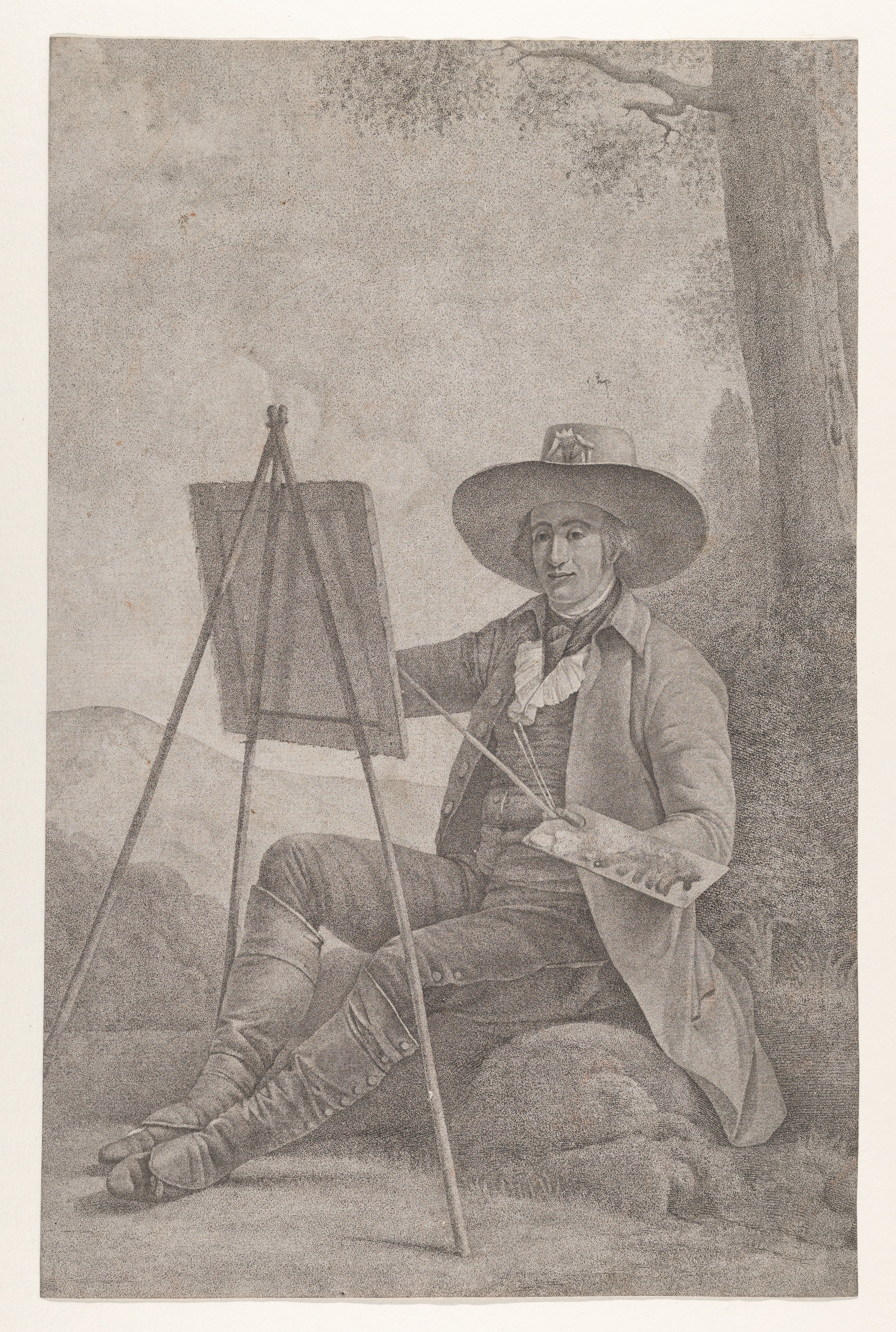
[credit](https://upload.wikimedia.org/wikipedia/commons/2/2b/Plein_Air_Painter_at_an_Easel_MET_DP834385.jpg),
[licence](http://creativecommons.org/publicdomain/zero/1.0/deed.en)
* **Canvas Prints or Lightweight Frames:** These are your best friends. Canvas art, especially, is light and has no glass to shatter, making it incredibly safe. If you opt for a framed print, choose a lightweight frame made from materials like wood or metal, and definitely consider acrylic (sometimes called Plexiglas) instead of traditional glass for the glazing. Acrylic is much lighter and shatter-resistant, providing that extra layer of safety and peace of mind. When choosing a frame, consider the overall aesthetic of your room. A sleek, minimalist frame can complement a modern space, while a natural wood frame might enhance a bohemian or rustic vibe. Floating frames, where the canvas appears to 'float' within the frame, can add a sophisticated touch without being overly heavy. Beyond these, I've found that **shadow box frames** can add incredible depth to smaller, more delicate pieces, creating a sense of importance. **Gallery frames**, often wider and simpler, can make a bold statement, particularly in contemporary spaces. And don't underestimate the power of **unframed canvases** for a very modern, almost raw aesthetic, or **clip frames** for a truly minimalist and budget-friendly option. Each frame style brings its own personality, so consider how it will interact with both the art and the broader room design.
* **Archival Materials & Longevity (and UV Protection):** For prints and photographs, consider pieces printed with archival inks on acid-free paper to ensure their longevity. Beyond that, and especially if your bedroom gets a lot of natural light, consider UV-protective glazing for framed pieces. UV rays are sneaky; they can cause colors to fade and paper to yellow over time, even with indirect light. High-quality acrylic glazing often comes with built-in UV protection, offering a dual benefit of safety (shatter-resistance!) and preservation. While this might be a slightly higher initial investment, it ensures your chosen piece retains its beauty and vibrant colors for years to come, resisting fading and degradation. This is especially important for art that holds deep personal or sentimental value – you want it to last! Consider it an act of preservation for your visual sanctuary. I've often seen beautiful pieces sadly degraded over time due to a lack of proper protection, a truly heartbreaking outcome for something meant to bring lasting peace.
* **Secure Hanging:** Always use appropriate hardware for the weight of your art and the type of wall you have. For drywall, traditional picture hangers might suffice for lighter pieces, but for anything substantial, wall anchors (like toggle bolts or self-drilling anchors) are a non-negotiable for peace of mind. For plaster walls, specific plaster anchors or even drilling into studs (if located) is essential. Brick or concrete walls will require masonry bits and anchors designed for heavy loads. Double check everything, and don't hesitate to ask for help if you're unsure. I've heard stories of pieces crashing down in the middle of the night, and believe me, it's not a memory you want associated with your serene sanctuary! If you're looking for more general guidance on secure hanging, my article on [decorating with art above a fireplace](/finder/page/decorating-with-art-above-a-fireplace) offers some transferable tips on anchoring artwork securely. And for truly large or heavy pieces, I can't stress enough the value of **professional installation**. It's a small investment for complete peace of mind, knowing your art is safely and securely displayed, allowing you to sleep soundly beneath it. A professional will not only ensure structural integrity but also optimal aesthetic placement, taking into account subtleties you might overlook. It's the ultimate 'set it and forget it' solution for your most cherished pieces. I often think of it as the 'invisible frame' of security that allows the art to truly shine without any underlying anxiety.
#### Choosing the Right Hanging Hardware
Beyond the frame itself, the hardware you use is critical. Different wall types demand different solutions to ensure your art stays put:

[credit](https://images.pexels.com/photos/7263852/pexels-photo-7263852.jpeg),
[licence](https://creativecommons.org/public-domain/)
* **Drywall:** For lighter pieces (under 10 lbs), a simple picture hook and nail driven at an angle usually suffices. For medium-weight items (10-30 lbs), self-drilling drywall anchors or expansion anchors are reliable. For anything heavier, especially larger canvases or framed prints, use toggle bolts or heavy-duty molly bolts which distribute weight more effectively.
* **Plaster Walls:** These can be tricky. Avoid nails if possible, as plaster can crack. Opt for plaster-specific anchors or try to locate wooden studs behind the plaster (you can use a stud finder) and screw directly into them. Pilot holes are always a good idea to prevent cracking.
* **Brick or Concrete Walls:** These require masonry drill bits and appropriate wall plugs (rawlplugs) or sleeve anchors designed for heavy loads. This is often where professional installation truly earns its keep, ensuring precision and stability.
No matter the wall type, always consult the weight rating of your chosen hardware and, when in doubt, choose a system rated for *more* dan het daadwerkelijke gewicht van je kunstwerk. Your peace of mind is worth the extra effort. For truly large or heavy pieces, I can't stress enough the value of **professional installation**. It's a small investment for complete peace of mind, knowing your art is safely and securely displayed, allowing you to sleep soundly beneath it. A professional will not only ensure structural integrity but also optimal aesthetic placement, taking into account subtleties you might overlook. It's the ultimate 'set it and forget it' solution for your most cherished pieces. I often think of it as the 'invisible frame' of security that allows the art to truly shine without any underlying anxiety.
Here's a quick comparison of glazing options:
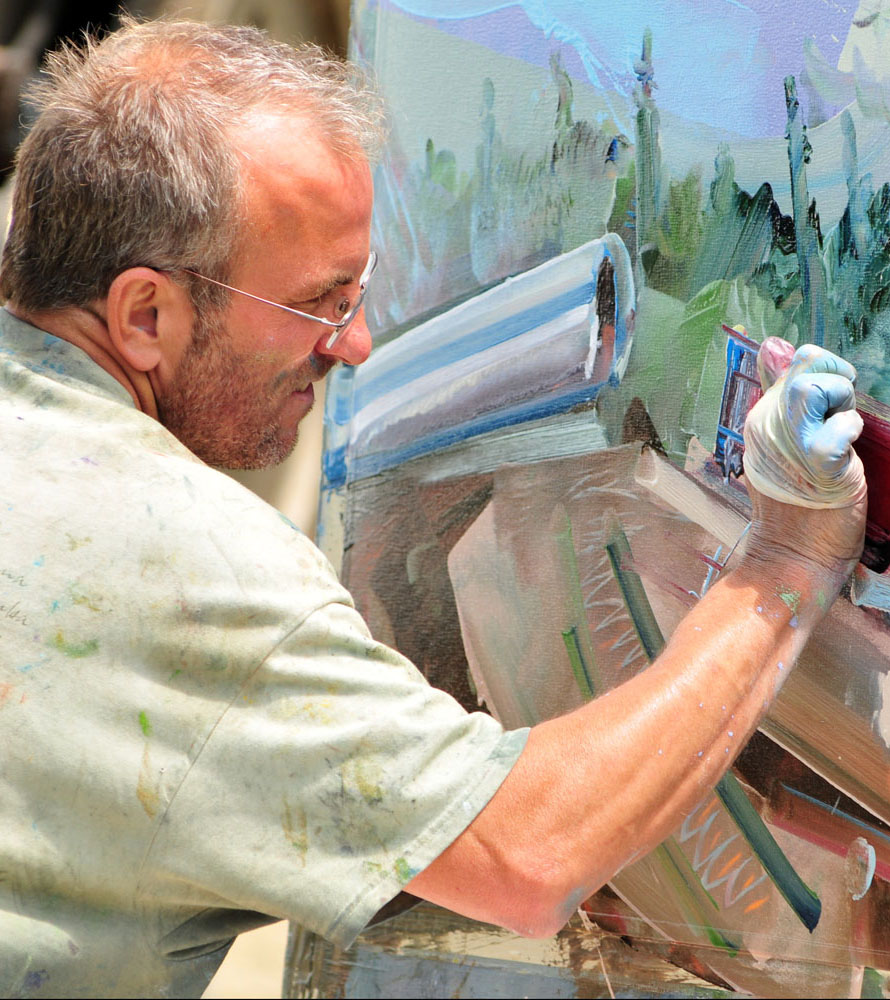
[credit](https://commons.wikimedia.org/wiki/File:Painter_David_Brewster_creating_work_for_the_Art_of_Action_project.jpg),
[licence](https://creativecommons.org/licenses/by/1.0)
| Glazing Type | Pros | Cons | Bedroom Suitability |
| :---------------- | :----------------------------------------- | :--------------------------------------- | :--------------------- |
| **Traditional Glass** | Clear, premium feel. | Heavy, shatters easily (safety risk), reflects light. | Less Recommended |
| **Acrylic (Plexiglas)** | Lightweight, shatter-resistant, often UV-protective. | Can scratch more easily, may have a slight static cling. | **Highly Recommended** |
| **None (Canvas/Board)** | No glare, very lightweight, no shatter risk. | Art is exposed to dust and elements. | **Highly Recommended** |

[credit](https://live.staticflickr.com/8154/7482818578_435c19ff7a_b.jpg),
[licence](https://creativecommons.org/licenses/by-nc-sa/2.0/)
Remember, your art is an investment in your peace, so protect it well! Double check everything, and don't hesitate to ask for help if you're unsure. I've heard stories of pieces crashing down in the middle of the night, and believe me, it's not a memory you want associated with your serene sanctuary! If you're looking for more general guidance on secure hanging, my article on [decorating with art above a fireplace](/finder/page/decorating-with-art-above-a-fireplace) offers some transferable tips on anchoring artwork securely. And for truly large or heavy pieces, I can't stress enough the value of **professional installation**. It's a small investment for complete peace of mind, knowing your art is safely and securely displayed, allowing you to sleep soundly beneath it.
### Illuminating Your Sanctuary: Lighting Your Bedroom Art
While the art itself is paramount, how you light it can transform its presence. In a bedroom, subtle and soft lighting is key; you don't want harsh spotlights jarring you awake.
* **Picture Lights:** These are classic for a reason. A small, low-wattage LED picture light mounted directly above your artwork can beautifully highlight the piece without flooding the room with harsh, distracting light. Choose one with an adjustable head so you can direct the beam precisely, creating a soft, focused glow that gently draws the eye. Look for models with warm dimming capabilities or smart features that allow you to adjust intensity and color temperature, ensuring it complements your art and sets the perfect calming mood. Imagine turning it on as you settle in for the night, casting a gentle spotlight on your chosen piece – a truly magical touch that elevates the entire room.
* **Smart Lighting & Automation:** In today's smart homes, integrating your art lighting into your automated routines can be a game-changer. Imagine soft, dimmed lights illuminating your artwork as you wind down for the night, or a gentle, subtle glow greeting you in the morning, gradually brightening alongside the dawn. Smart bulbs and smart plugs offer incredible flexibility for creating the perfect ambiance with minimal effort, allowing you to schedule, voice control, or simply tap to set the scene for rest and relaxation. This level of granular control allows for seamless transitions throughout your day, enhancing the emotional impact of your art and truly personalizing your sanctuary. I've found that subtly bringing the art to life with lighting just before bedtime, then letting it dim naturally, can be a wonderful, almost ritualistic way to prepare for sleep. Imagine walking into your room and, with a single voice command or a tap on your phone, your chosen artwork bathes in a soft, warm glow, instantly signaling to your mind that it's time to unwind. This thoughtful integration elevates the art from mere decoration to an active participant in your nightly winding-down ritual.
* **Recessed Lighting:** If you have recessed lighting, ensure one is aimed directly at your art. Dimmers are a must in a bedroom so you can adjust the intensity for viewing or winding down.
* **Ambient vs. Task Lighting:** In a bedroom, your primary lighting is usually ambient (general room light) or task-oriented (bedside reading lamps). Art lighting falls into the ambient category, enhancing the overall mood. Avoid using harsh task lighting to illuminate art, as it can create unwanted glare and disrupt the tranquil atmosphere.
* **Accent Lamps:** Sometimes, the ambient light from bedside lamps or a floor lamp can be enough to gently illuminate your art, adding to the room's cozy glow. Position them strategically to cast a soft light without creating harsh shadows.
#### Considering Color Temperature
Beyond intensity, the **color temperature** of your lighting is vital. Measured in Kelvin (K), warm white light (around 2700K-3000K, often described as soft white or warm white) tends to enhance warmer tones in art and create a cozier, more inviting atmosphere – absolutely perfect for a bedroom. Cooler white light (above 4000K, often daylight or cool white) can make colors appear crisper but might feel too stark, clinical, or stimulating for a relaxing space. Experiment with different bulbs to see how they interact with your chosen artwork and overall room mood, taking note of how different temperatures subtly shift the emotional landscape of your room. My personal preference is always for warmer temperatures in the bedroom; you want to make your art sing a gentle lullaby, not scream for attention. It's truly amazing how a simple shift from 4000K to 2700K can transform a vibrant piece into something more subdued and serene.
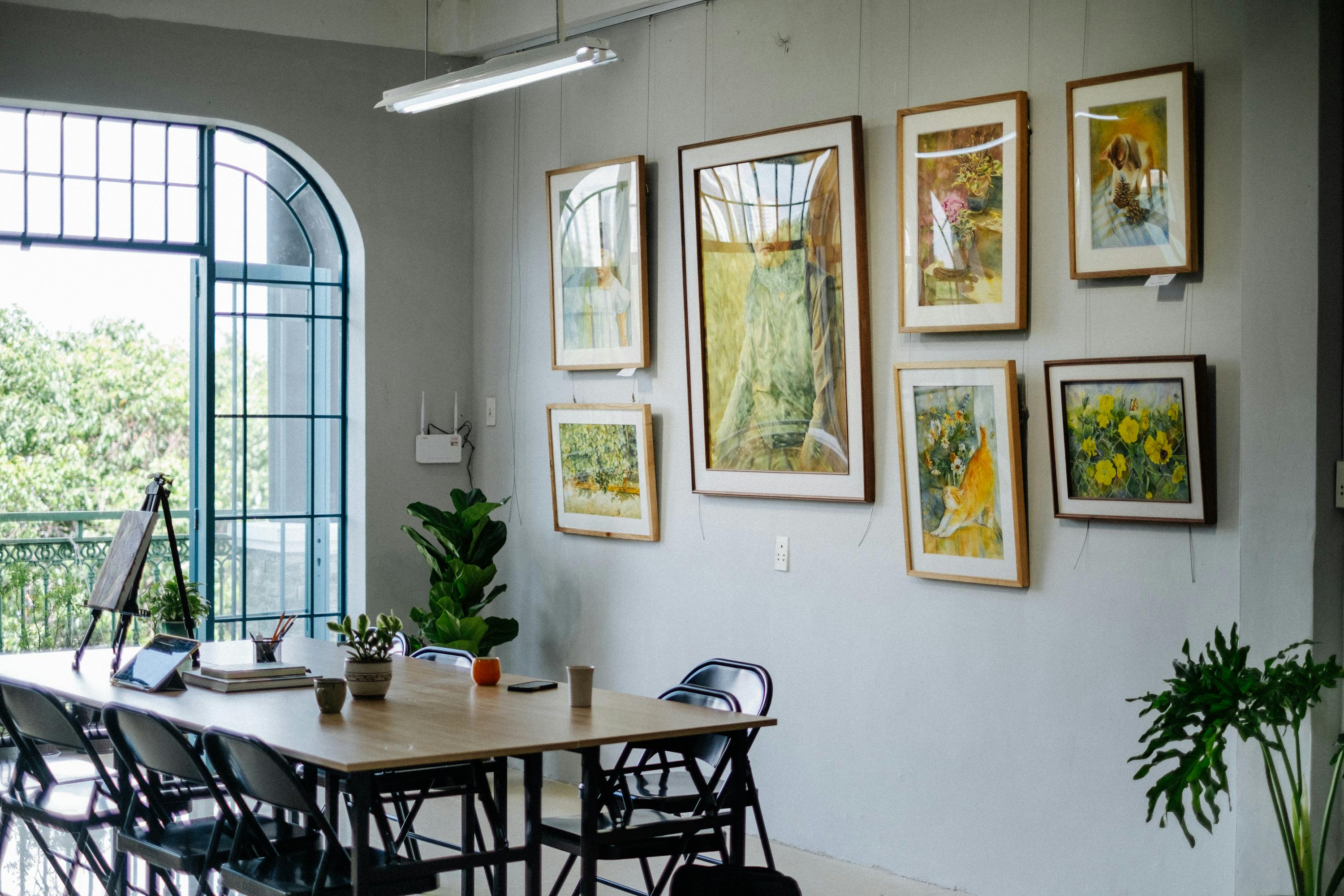
[credit](https://images.pexels.com/photos/17155186/pexels-photo-17155186.jpeg?cs=srgb&dl=pexels-nguyendesigner-17155186.jpg&fm=jpg),
[licence](https://creativecommons.org/public-domain/)
#### Color Psychology in Specific Bedroom Themes
Taking color psychology a step further, consider how specific color palettes can underscore certain bedroom themes. For a **coastal-inspired bedroom**, think soft blues, sandy beiges, and muted greens – colors that evoke the calm of the ocean and beach. For a **rustic or farmhouse style**, warm earth tones like terracotta, soft browns, and deep forest greens can ground the space, creating a cozy, inviting atmosphere. A **modern minimalist bedroom** often thrives on a palette of cool grays, crisp whites, and subtle black accents, allowing the art to be a quiet focal point without overwhelming the clean aesthetic. Even a **bohemian space** can lean into calming hues by prioritizing muted jewel tones, dusty rose, or soft oranges over vibrant, high-energy shades. The goal is to build a cohesive visual story where every color choice reinforces the desired mood of your sanctuary.
#### Monochromatic Harmony vs. Strategic Color Pops
When it comes to your bedroom palette, you generally have two main approaches: embracing a **monochromatic harmony** or introducing **strategic pops of color**. A monochromatic scheme, using varying shades, tints, and tones of a single color family (like a range of blues or greens), creates an incredibly cohesive and tranquil environment. This subtle approach allows the art to blend seamlessly, contributing to an overall calming aura. On the other hand, a carefully chosen piece with a single, muted "pop" of a warmer or contrasting color can add visual interest and a subtle energizing effect without disrupting the calm. The key is balance and intention; the "pop" should feel like a soft accent, not a jarring interruption. For more on the emotional impact of color, explore [the power of color in abstract art: my approach to palette and emotion](/finder/page/the-power-of-color-in-abstract-art:-my-approach-to-palette-and-emotion).

[credit](https://live.staticflickr.com/65535/52191399291_7dd7f8c40a_b.jpg),
[licence](https://creativecommons.org/licenses/by-nc-sa/2.0/)
The goal is to reveal the textures and colors of your chosen piece, making it a quiet focal point even in dimmer settings.
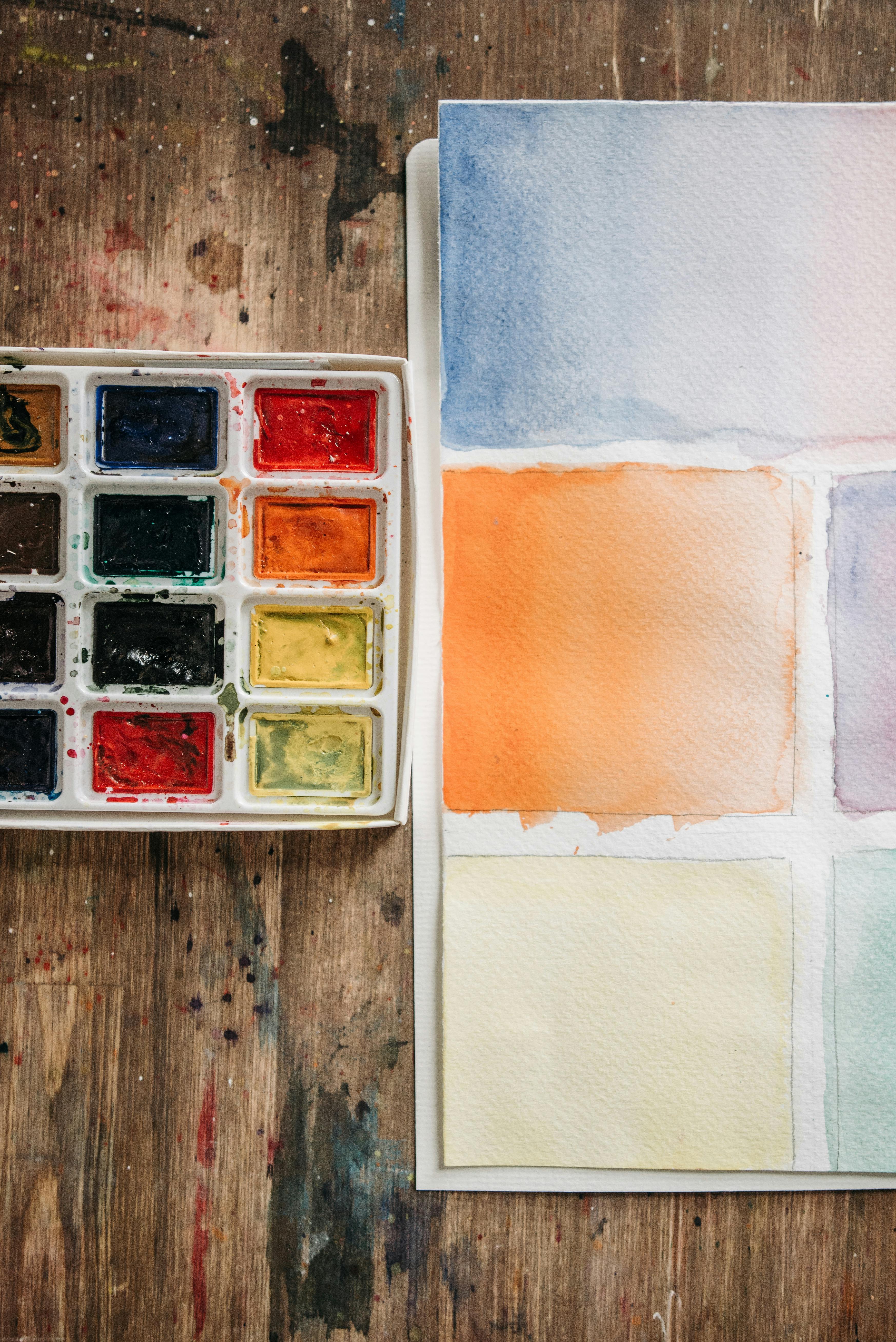
[credit](https://images.pexels.com/photos/6925017/pexels-photo-6925017.jpeg),
[licence](https://creativecommons.org/public-domain/)
### Beyond the Single Piece: Diptychs, Triptychs, and Mini Galleries
Sometimes, one piece just doesn't tell the whole story, or you have a particularly wide bed. That's when diptychs (two pieces) or triptychs (three pieces) come into play. These can create a cohesive look across a larger expanse without feeling overwhelming, especially if they share a common theme, color palette, or artistic style. Just make sure the spacing between them is tight – usually about 2-4 inches (5-10 cm), allowing each piece to breathe while maintaining their connection as a unified composition. A single unifying color palette or theme across the multiple canvases is key to preventing visual chaos; think of it as a visual symphony rather than a cacophony.
If you're feeling adventurous, a very curated, minimalist gallery wall could work. Think two or three pieces that complement each other in style and color, rather than a dense cluster. It’s like creating a visual conversation, but a quiet one, perhaps with varied textures or slightly different mediums for interest. When creating a gallery wall above your bed, remember the same rules of scale and centering still apply, but collectively. Ensure the entire arrangement fits within the 'two-thirds to three-quarters' width rule of your bed or headboard. Consider balancing different shapes and sizes, perhaps with a subtle interplay of portrait and landscape orientations, using the largest piece as an anchor. For inspiration on how to arrange multiple pieces and see how they interact, this article on [curating a gallery wall with abstract art](/finder/page/curating-a-gallery-wall-with-abstract-art:-tips-for-a-dynamic-display) is a great starting point, even if you’re only creating a mini-gallery for your serene space. I often encourage clients to explore themes like "nature's calm" or "soft geometry" when building a multi-piece arrangement for the bedroom, ensuring everything contributes to the overall tranquility.
### Creating a Cohesive Narrative with Multiple Pieces
Beyond just aesthetics, a diptych, triptych, or curated mini-gallery offers the incredible opportunity to tell a visual story or explore a theme in greater depth. Instead of a single statement, you create a dialogue. Perhaps it’s a series of abstract forms evolving across canvases, or different perspectives of a calming landscape. This narrative approach allows for a richer, more immersive experience, inviting the viewer's eye to move and discover connections. When the pieces are intentionally related—through color, style, or subject—they create a sense of cohesion and depth that a single piece simply cannot. It's like a visual poem, with each canvas a verse contributing to the overall tranquility and meaning. This can be especially powerful in a bedroom, offering a gentle, unfolding story to ponder as you drift off to sleep or awaken.

[credit](https://www.modernmemorydesign.com/collections/abstract-wall-art-for-home-decor),
[licence](https://creativecommons.org/licenses/by-nc/4.0/)
## Integrating Art with Bedroom Furniture & Decor
Your bedroom art shouldn't exist in a vacuum; it should harmonize with your existing furniture and decor. Think of it as the lead singer in a beautifully arranged band, where every other element plays a supporting role. Consider the lines and silhouettes of your bedside tables, dresser, and lighting fixtures. Does your art complement these forms, or clash with them? For example, a room with sleek, modern furniture might benefit from geometric abstract art, while a bedroom with more traditional or curved pieces might feel more cohesive with organic abstracts or classic landscapes. Don't forget textiles either! Your bedroom art shouldn't exist in a vacuum; it should harmonize with your existing furniture and decor. Think of it as the lead singer in a beautifully arranged band, where every other element plays a supporting role, contributing to the overall melody of your sanctuary. Consider the lines and silhouettes of your bedside tables, dresser, and lighting fixtures. Does your art complement these forms, or clash with them? For example, a room with sleek, modern furniture might benefit from geometric abstract art or minimalist photography, while a bedroom with more traditional or curved pieces might feel more cohesive with organic abstracts or classic landscapes. Don't forget textiles either! The colors, patterns, and textures in your bedding, curtains, and rugs can all inform your art choices, creating a layered, inviting space that feels truly considered and deeply personal. My article on [decorating with art in modern farmhouse interiors](/finder/page/decorating-with-art-in-modern-farmhouse-interiors) offers some great examples of how art and decor can work together, and principles from [decorating with abstract art in Scandinavian interiors](/finder/page/decorating-with-abstract-art-a-guide-to-integrating-bold-pieces-into-scandinavian-interiors) can apply to creating serene, uncluttered vibes, emphasizing functionality and subtle beauty. If you're looking to create a seamless aesthetic throughout your home, consider my guide to [abstract art for every room: curating flow and feeling in your home](/finder/page/abstract-art-for-every-room:-curating-flow-and-feeling-in-your-home).
### Considerations for Renters and Temporary Homes
For those in rental properties or temporary living situations, the idea of hanging substantial art can be daunting due to concerns about wall damage or the hassle of moving. But fear not, your sanctuary still deserves beautiful art!
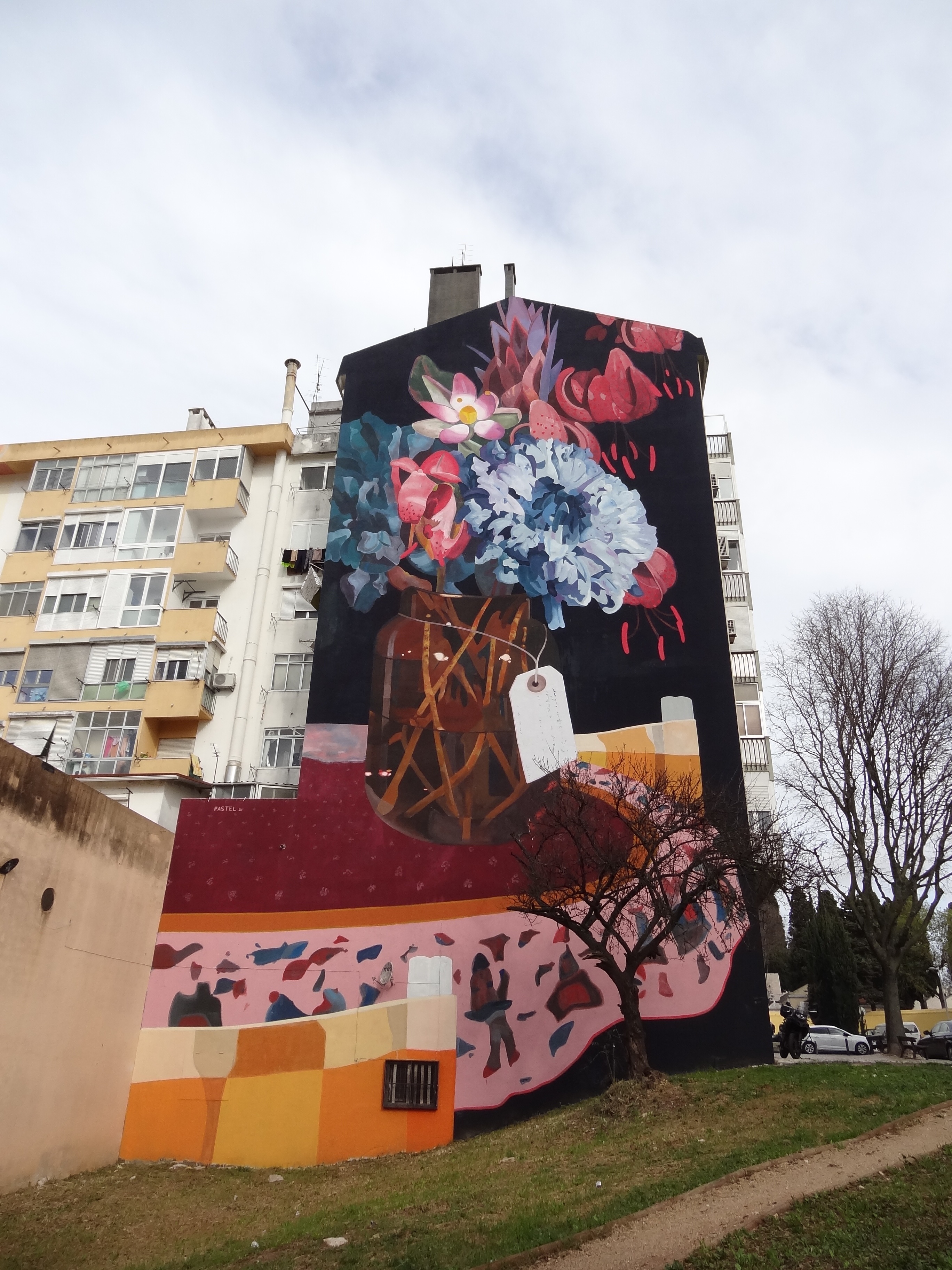
[credit](https://upload.wikimedia.org/wikipedia/commons/5/5a/Mural_L%E1%B8%97th%C4%93_by_Pastel%2C_Lisbon.jpg),
[licence](https://creativecommons.org/licenses/by-sa/4.0)
* **Command Strips & Adhesive Hooks:** For very lightweight framed prints or unframed canvases, high-quality adhesive strips can be a renter's best friend. Always check weight limits and surface compatibility.
* **Lean, Don't Hang:** Consider leaning larger framed art or canvases against the wall on a dresser or directly on the floor. This creates a relaxed, stylish vibe without any holes.
* **Floor Easels:** A beautiful floor easel can display a statement piece and add an artistic touch, offering flexibility and easy relocation.
* **Textile Art:** Lightweight wall hangings, tapestries, or even scarves can be hung with minimal impact using small pins or easily removable adhesive hooks.
* **Gallery Ledges:** If allowed, installing a picture ledge can give you the flexibility to display multiple pieces that can be easily rearranged without redrilling.
These options ensure you can personalize your bedroom and enjoy the benefits of art, even if your living situation isn't permanent. My philosophy is that even temporary spaces deserve to feel deeply personal and inspiring. Sometimes, the most creative solutions come from these limitations – for instance, using a beautiful screen or room divider behind the bed to hang art, or strategically placing a large, lightweight canvas on a tall chest of drawers. It's about thinking outside the traditional 'nail in the wall' box and letting your creativity flow.
## Budgeting for Your Bedroom Art
I know, the 'B' word! But truly, beautiful art doesn't have to break the bank. With a little savvy and a lot of patience, you can find pieces that resonate without compromising your financial peace of mind. Here are a few tips I've learned over the years:

[credit](https://upload.wikimedia.org/wikipedia/commons/2/24/Edvard_Munch._Angst_%281896%29_%E2%80%94_Woodcut_%2825075069075%29.jpg),
[licence](https://creativecommons.org/licenses/by-sa/2.0)
* **Consider Prints and Reproductions:** High-quality giclée prints of original artworks can be incredibly stunning and are far more accessible than originals. Many artists (like myself!) offer limited edition prints that still hold value and exclusivity. You can often find stunning reproductions that capture the essence of a piece without the hefty price tag. For those curious about the quality of digital prints, [what is giclee print](/finder/page/what-is-giclee-print) offers some great insights.
* **Explore Emerging Artists:** Discovering artists early in their careers can be incredibly rewarding. Their work is often more affordable, and you get the satisfaction of supporting a new talent. Art schools, local art fairs, and online platforms dedicated to emerging artists are great places to start. It’s like finding a hidden gem before everyone else does. If this sparks your interest, I have some thoughts on [collecting emerging abstract art: a guide to discovering tomorrow's masters](/finder/page/collecting-emerging-abstract-art-a-guide-to-discovering-tomorrows-masters).
* **Secondhand & Vintage Finds:** Thrift stores, antique shops, and flea markets can hide incredible treasures. A unique vintage print or an interesting old painting might just need a new frame and a little love to become the perfect serene piece for your bedroom. The hunt itself can be part of the mindful journey!
* **DIY or Commission Small Pieces:** If you're creatively inclined, a simple abstract painting or a textile art piece made by your own hands can be incredibly meaningful. Alternatively, commissioning a small, custom piece from an artist can be more affordable than a large one and ensures it's perfectly tailored to your space and preferences. Think of it as a collaborative project!
* **Art Rental Services:** Did you know some galleries offer art rental? It's a fantastic way to live with beautiful pieces, test out different styles, and enjoy high-quality art without a long-term financial commitment. It’s a bit like a library for art – inspiring and flexible.
Remember, the true value of art in your bedroom isn't its price tag, but the joy and peace it brings you. A budget-conscious approach simply means being intentional and resourceful in your search.

[credit](https://images.pexels.com/photos/16076964/pexels-photo-16076964/free-photo-of-sculpture-of-people-with-birds.jpeg),
[licence](https://creativecommons.org/public-domain/)
## A Mindful Approach to Art Selection
Beyond all the practical considerations of size, style, and safety, the most crucial element in choosing art for your sanctuary is your **personal connection** to it. This isn't just about matching colors or following trends; it's about what truly resonates with your spirit. Take your time. Browse art online, visit galleries, or even reflect on what imagery brings you a sense of peace or joy. Does the piece evoke a memory? A feeling? Does it invite you to pause, to breathe, to simply *be*? A mindful approach ensures that your art is more than just decoration; it's a daily source of quiet inspiration and inner peace. My thoughts on [mindful moments: how abstract art can be a gateway to inner peace and reflection](/finder/page/mindful-moments-how-abstract-art-can-be-a-gateway-to-inner-peace-and-reflection) might offer further guidance.
### Common Pitfalls I've Stumbled Into (So You Don't Have To)
We've all been there, making decorating choices that seemed right at the time. I've certainly had my share of "what was I thinking?" moments. Here are a few common bedroom art blunders and how to steer clear:

| Pitfall | Description | Zen's Fix | Potential Impact of Mistake |
| :------ | :---------- | :-------- | :------------------------- |
| **Art Too Small** | A postage stamp over a king-sized bed. | Aim for 2/3 to 3/4 bed width. | Looks disjointed, unanchored, like an afterthought. |
| **Art Hung Too High** | Floating near the ceiling, disconnected from the bed. | Bottom edge 6-8 inches above headboard. | Makes the ceiling feel lower, art feels separate from the room. |
| **Overly Busy/Aggressive Art** | Art with sharp contrasts, jarring colors, or intense subjects. | Opt for calming, soft colors, abstract forms, serene subjects. | Creates restless energy, disrupts sleep, negates sanctuary feel. |
| **Unsecured Artwork** | Heavy frames hung with inadequate hardware. | Use proper wall anchors and sturdy hangers; consider lightweight materials. | Safety hazard, potential damage to property or person. |
| **Ignoring Bedroom Aesthetic** | Art that clashes with existing decor/mood. | Choose art that complements color palette, style, and desired feeling. | Room feels unharmonious, visually confusing. |
| **Inadequate Lighting** | Harsh spotlights or no dedicated lighting, leaving art in shadows. | Use soft picture lights or dimmed recessed lighting; ensure art is visible. | Art loses impact, room feels unbalanced, creates unwanted glare. |
| **Lack of Personal Connection** | Choosing art based purely on aesthetics or trends, without genuine resonance. | Prioritize pieces that evoke calm, joy, or personal meaning for *you*. | Art feels impersonal, lacks emotional depth, fails to enhance well-being. |
| **Excessive Clutter** | A gallery wall that's too dense, or too many small pieces fighting for attention. | Curate thoughtfully; less is often more. Focus on impact over quantity. | Overwhelming, creates visual noise, detracts from serenity. |
| **Ignoring Room's Function** | Choosing art that is stimulating or distracting, rather than calming. | Always prioritize tranquility and relaxation for a bedroom; save energetic pieces for other rooms. | Undermines the primary purpose of the bedroom (rest), causes agitation. |
| **Poor Quality Frames** | Using frames that are visibly worn, flimsy, or don't suit the art. | Invest in quality framing that protects the art and elevates its presence. | Undermines the art's value, cheapens the room's aesthetic.

[credit](https://upload.wikimedia.org/wikipedia/commons/5/5f/Joan_Mir%C3%B3%2C_Dona_i_ocell%2C_1983%2C_Parc_de_Joan_Mir%C3%B3%2C_Barcelona_%289644467273%29.jpg),
[licence](https://creativecommons.org/licenses/by-sa/2.0)
## Maintenance and Care of Your Bedroom Art
Once you've chosen and safely hung your perfect bedroom art, a little care goes a long way in preserving its beauty. Here are a few quick tips:
* **Dust Regularly:** A soft, dry microfiber cloth is your best friend. Gently wipe down frames and the surface of canvas prints to prevent dust buildup, as dust can dull colors and textures over time and even attract moisture. For framed pieces with glass or acrylic, you can use a very slightly dampened cloth if needed, but always use a gentle, ammonia-free cleaner (specifically for acrylic to avoid hazing and static cling) and avoid harsh chemical cleaners which can damage finishes or leave streaks. Regular, gentle dusting is your best defense against the slow march of time, keeping your art looking fresh and vibrant, and ensuring your sanctuary always feels fresh.
* **Avoid Direct Sunlight:** Just as with any art, prolonged exposure to direct sunlight can cause colors to fade and materials to degrade over time, a process known as photodegradation. Position your art where it's protected from direct, harsh rays – think walls not directly opposite a sun-drenched window – or consider UV-protective glazing for framed pieces in sunnier rooms. Even indirect sunlight over years can cause subtle damage, so thinking proactively about placement and protection is a smart, essential long-term strategy for preserving your investment and the vibrancy of your cherished pieces. I've seen too many beautiful pieces sadly lose their soul to the sun!
* **Maintain Stable Environment:** Extreme fluctuations in temperature and humidity can damage artwork, especially pieces on canvas, paper, or those with delicate finishes. While a bedroom is typically a relatively stable environment, be mindful of placing art directly above heat sources (like radiators or heat vents) or in very humid corners. Maintaining a consistent temperature and moderate humidity (ideal between 40-60%) will help preserve the integrity of your cherished pieces. Think of it as creating a climate-controlled hug for your art.
* **Handle with Care:** When moving or adjusting your art, always handle it by the frame or sides, not the canvas or print surface itself. Even meticulously clean hands can leave behind oils that attract dust or cause subtle discoloration over time. If you need to re-hang a piece, or even just shift it slightly, always ask for help to prevent accidental damage or smudges – a two-person job is always safer for larger artworks, preventing awkward leans or drops. Treat your art like the precious object it is, and it will reward you with years of undisturbed visual delight.
These small habits ensure your cherished bedroom art continues to bring you joy for many years. Here’s a quick summary:
| Maintenance Tip | Action | Why it Matters |
| :------------------ | :---------------------------------------------------------- | :-------------------------------------------------------- |
| **Dust Regularly** | Use a soft, dry microfiber cloth; ammonia-free cleaner for glazing. | Prevents dulling, dust buildup, and preserves vibrancy. |
| **Avoid Direct Sun** | Place away from direct sunlight; consider UV glazing. | Prevents fading and material degradation (photodegradation). |
| **Stable Environment** | Avoid heat sources, maintain 40-60% humidity. | Protects integrity of canvas/paper; prevents damage. |
| **Handle with Care** | Always hold by frame/sides; ask for help with larger pieces. | Prevents accidental damage, smudges, and oil transfer. |
These small habits ensure your cherished bedroom art continues to bring you joy for many years.
### My Recommendation Journey (A Quick Guide)
Every bedroom is unique, but here’s a little table I put together based on different bedroom vibes and what I’ve found works best for above the bed:
| Bedroom Vibe | Recommended Art Style | Color Palette | Key Considerations |
| :----------- | :-------------------- | :------------ | :----------------- |
| **Minimalist Haven** | Large-scale abstract, subtle landscape, line art | Neutrals, muted tones, soft blues/greens | Focus on clean lines, negative space, serene impact. |
| **Bohemian Retreat** | Textile art (macrame, woven), abstract with organic forms, nature-inspired | Earth tones, muted jewel tones, soft pinks/oranges | Layer textures, embrace natural materials, personal touch. |
| **Modern & Chic** | Geometric abstract, large photographic print, contemporary portrait | Monochromatic, bold accents (if balanced), cool tones | Sleek frames, impactful yet refined statement. |
| **Classic & Elegant** | Traditional landscape, botanical prints, muted abstract | Soft, sophisticated hues, pastels, deep jewel tones | Ornate or classic frames, timeless appeal, understated luxury. |
| **Rustic Charm** | Abstract landscape, nature illustration, vintage print | Warm earth tones, deep greens/blues, wood tones | Raw textures, natural subjects, cozy feel. |
| **Eclectic Fusion** | Mix of abstract, travel photography, unique artisan crafts | Varied, but with a unifying theme or dominant color | Embrace personal expression, blend styles thoughtfully. |
| **Transitional Charm** | Muted abstract, botanical illustrations, subtle landscapes | Soft grays, creams, muted blues/greens, warm wood tones | Blends classic and contemporary, inviting and sophisticated. |
| **Industrial Loft** | Large-scale abstract photography, minimalist line art, urban landscapes | Grays, blacks, whites, pops of muted primary colors | Clean lines, raw textures, modern edge softened for comfort. |
| **Coastal Serenity** | Abstract seascapes, minimalist photography, muted botanical prints | Soft blues, sandy neutrals, greens, whites | Light, airy feel; natural textures; evokes seaside calm. |
| **Glamorous & Luxurious** | Bold abstract (with appropriate palette), sculptural art, elegant photography | Deep jewel tones, metallics, black, white | Rich textures; statement pieces; sophisticated elegance. |
| **Minimalist Scandinavian** | Clean line art, muted abstract, minimalist photography | Whites, grays, pale woods, soft blues | Emphasis on simplicity, functionality, and calm. |
| **Mid-Century Modern** | Geometric prints, abstract forms, vintage-inspired art | Earthy tones, pops of muted color, teak wood hues | Blends retro charm with clean, organic shapes. |

[credit](https://upload.wikimedia.org/wikipedia/commons/4/43/Bilbao_-_Museo_Guggenheim_-_Tall_Tree_and_the_Eye_%28Anish_Kapoor%29_6.JPG),
[licence](http://creativecommons.org/publicdomain/zero/1.0/deed.en)
This is just a starting point, of course. The most important thing is that **you** love the art. It's your space, after all, and it should reflect what brings you peace and joy.
### Frequently Asked Questions About Art Above Your Bed
#### Q: Where can I find art for my bedroom?
A: Beyond local galleries and art fairs, the online world offers a vast array of options. Websites like Etsy, Saatchi Art, and, of course, ZenMuseum.com (for my own abstract pieces at [/buy](/buy)!) are great starting points. Consider **art prints** (which you can learn more about in [what is giclee print](/finder/page/what-is-giclee-print)), original paintings, limited edition photographs, and even custom commissions to find something truly unique that speaks to your soul. Don't rush the process – the perfect piece will find you when you least expect it!
#### Q: How high should I hang art above my bed?
A: As a general rule, aim for the bottom edge of the artwork to be **6 to 8 inches** (15-20 cm) above the top of your headboard. If you don't have a headboard, center the artwork so that the middle of the piece is roughly at your eye level when standing, then adjust slightly lower if needed for a comfortable view from bed. Remember, this is about creating visual harmony, not just following a rigid rule. You can always use the paper template trick I mentioned earlier to visualize before drilling!
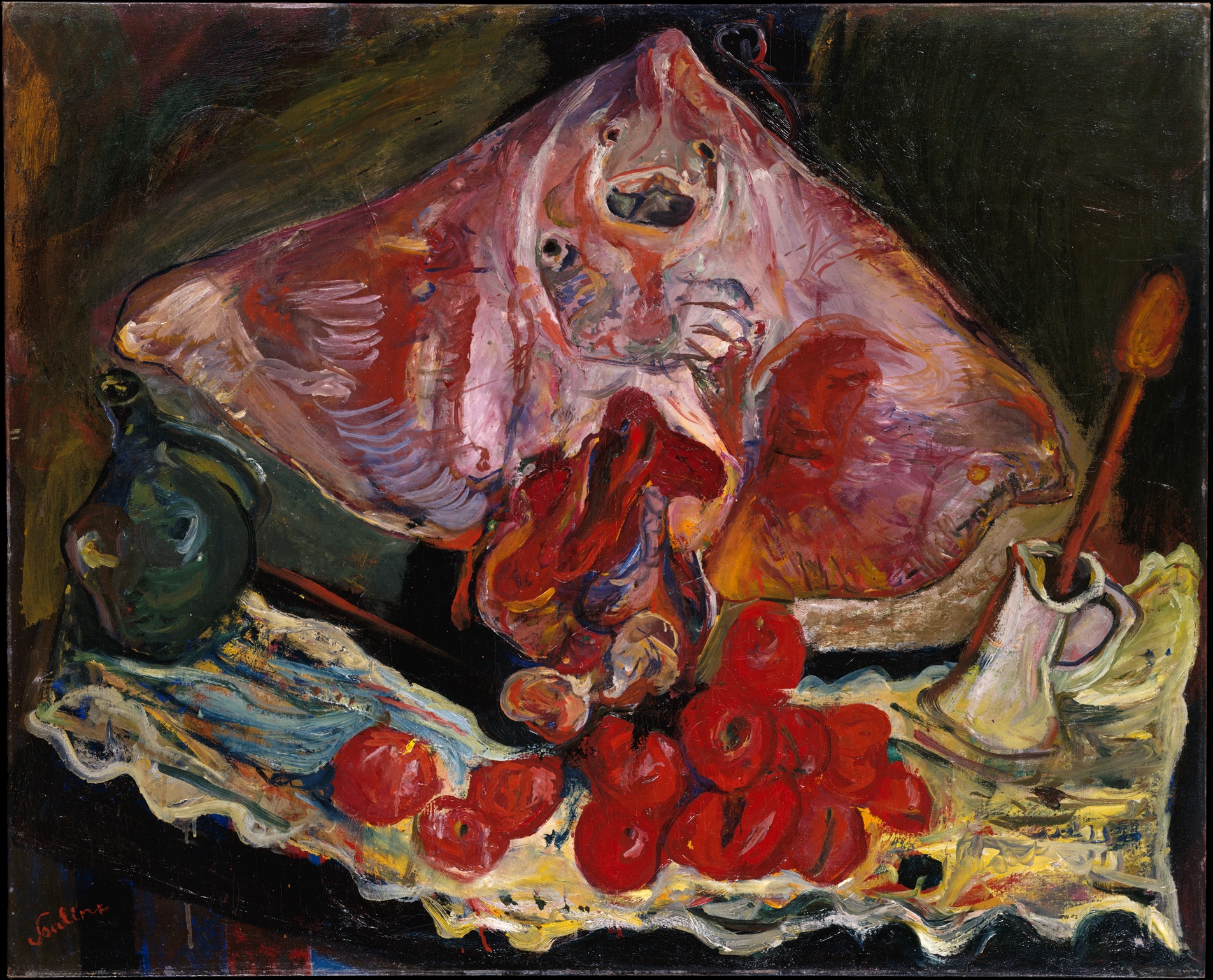
[credit](https://upload.wikimedia.org/wikipedia/commons/b/b5/Still_Life_with_Rayfish_MET_DT4177.jpg),
[licence](http://creativecommons.org/publicdomain/zero/1.0/deed.en)
#### Q: What if I have slanted ceilings?
A: Slanted ceilings offer a unique opportunity for creative placement! Instead of fighting the slope, embrace it. You can consider hanging art lower on the wall where the ceiling slopes down, or use a series of smaller pieces that follow the angle of the incline. Lightweight canvas prints or textile art are excellent choices for sloped walls, as they pose less of a safety risk. The goal is to make the art feel intentionally placed within the architectural feature, rather than competing with it.
#### Q: Should art above the bed always be horizontal?
A: Not at all! While horizontal pieces often complement the width of a bed, vertical art can create a sense of height and drama, especially if you have high ceilings or a tall headboard. The key is to ensure the piece, or arrangement of pieces, is proportionate to the bed and doesn't feel lost or overwhelming. A tall, narrow abstract or even a stacked diptych could work beautifully.
#### Q: Can I hang a mirror above my bed?
A: While mirrors can visually expand a space, I generally advise caution when placing them directly above the bed. From a Feng Shui perspective, it can be unsettling to see your reflection while sleeping. More practically, a heavy mirror could pose a significant safety risk. If you love the idea of reflection, consider a mirror on an adjacent wall where it won't reflect your sleeping self, or opt for art that features reflective qualities (like a metallic print) but is securely mounted and lightweight. Ultimately, for the space directly above your bed, a mirror rarely contributes to the deep sense of peace we're aiming for.

[credit](https://www.publicdomainpictures.net/pictures/590000/nahled/planet-surreale-welt-fantasie-1710597813sJc.jpg),
[licence](https://creativecommons.org/publicdomain/zero/1.0/)
#### Q: Where can I get inspiration for art for my bedroom?
A: Inspiration is everywhere once you start looking! Beyond physical galleries and online platforms like ZenMuseum.com, consider interior design magazines, Pinterest boards dedicated to "serene bedrooms," or even nature itself. Pay attention to colors, textures, and moods that naturally calm and uplift you. Don't be afraid to save images, even if they aren't directly art, to build a mood board that reflects your desired sanctuary vibe. And remember, sometimes the best inspiration comes from simply reflecting on what makes *you* feel at peace.
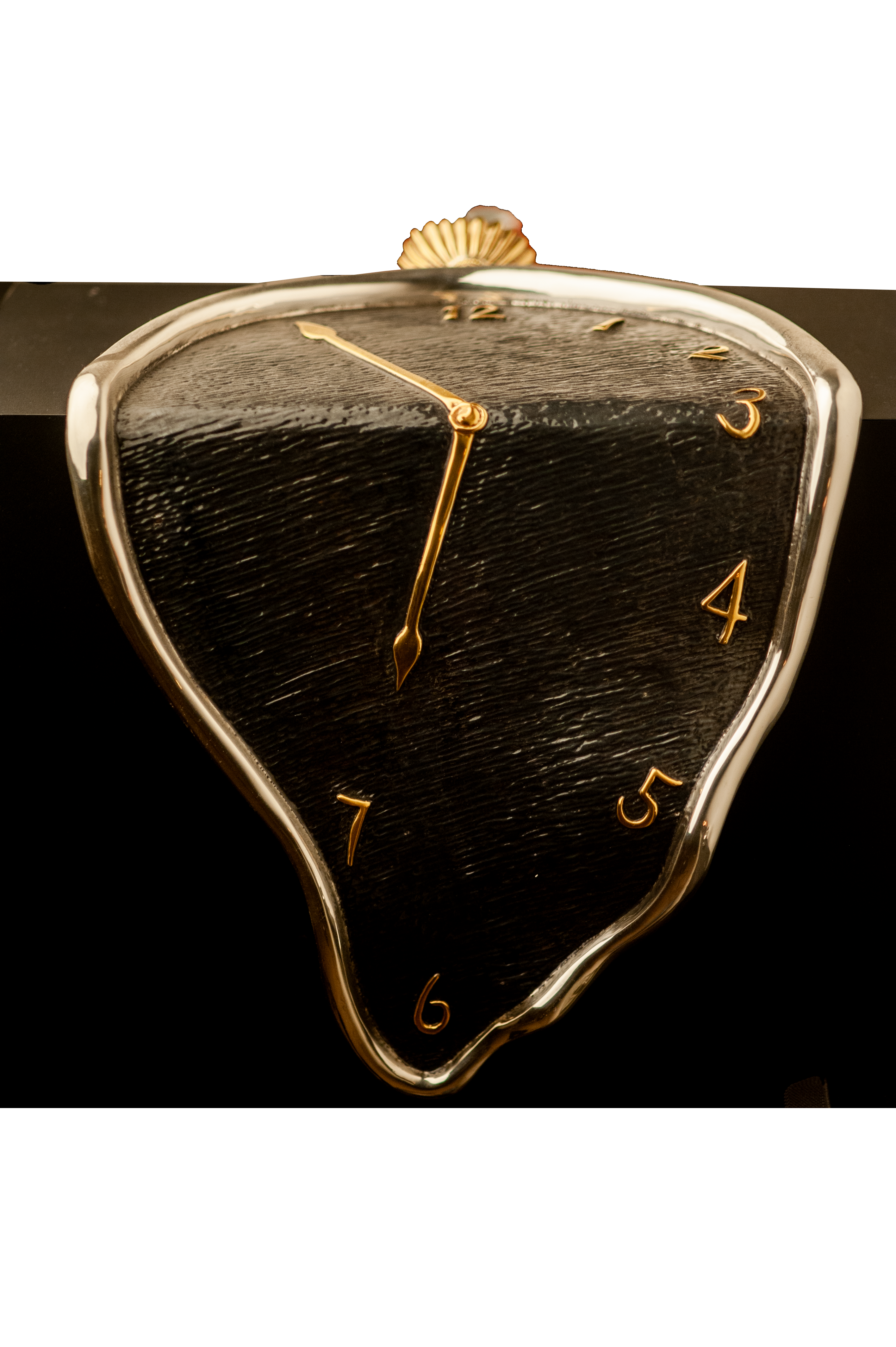
[credit](https://upload.wikimedia.org/wikipedia/commons/6/64/Dargenta_%26_Salvador_Dali_The_persistance_of_Memory.png),
[licence](https://creativecommons.org/licenses/by-sa/4.0)
#### Q: Can I use command strips for art above my bed?
A: For very lightweight pieces, like small unframed prints or canvas, command strips can be a convenient option. However, for anything with significant weight, a frame with glass, or anything that you want to be truly secure long-term, I highly recommend using proper picture hangers and wall anchors. Command strips can lose adhesion over time or with temperature changes, and the last thing you want is your art falling on you in the middle of the night. Safety first!

#### Q: Can I hang multiple pieces of art above my bed?
A: Absolutely! Diptychs (two pieces) or triptychs (three pieces) work wonderfully for creating a cohesive look over a wider bed. Just ensure the spacing between them is consistent and relatively tight, typically 2 to 4 inches. For a small gallery wall, keep it curated and minimalist to maintain a sense of calm.

#### Q: What about art with text or quotes?
A: Art featuring text or quotes can be impactful, but for a bedroom, I'd suggest exercising caution. While an inspiring quote might seem lovely, your mind can't help but *read* it, even subconsciously. This cognitive engagement can be counterproductive when you're trying to clear your mind and wind down for sleep. If you absolutely love a textual piece, ensure it's simple, subtle, and genuinely helps you relax rather than stimulates thought.
#### Q: Is abstract art suitable for a bedroom?
A: Absolutely! In fact, abstract art is often ideal for bedrooms because its non-representational nature allows the mind to relax and wander without being fixated on a specific narrative or subject. Pieces with soft colors, fluid forms, or gentle textures can evoke a deep sense of calm and introspection, perfect for winding down. Just ensure the colors and overall energy of the piece align with the serene atmosphere you want to cultivate.
#### Q: What kind of art is best for a bedroom?
A: I generally recommend art that promotes serenity and relaxation. This often includes **abstract art** with soft colors and organic forms, peaceful landscapes, nature-inspired pieces, or soothing textile art. The key is to choose something that helps you unwind, rather than stimulating or distracting you.

#### Q: How do I choose art that reflects my personality?
A: This is perhaps the most important question! Beyond all the "rules," your bedroom art should speak to *your* soul. Start by thinking about what truly calms, inspires, or brings you joy. What colors do you gravitate towards? What imagery evokes a sense of peace? Don't be afraid to trust your intuition. Browse galleries (online or in person), save images that resonate, and observe your emotional response. Your art is a reflection of you, so let your authentic self guide the choice – it will always be the "right" choice if it brings *you* peace. For me, it's about finding those "mindful moments" that abstract art can so uniquely provide, as I explore in [mindful moments: how abstract art can be a gateway to inner peace and reflection](/finder/page/mindful-moments-how-abstract-art-can-be-a-gateway-to-inner-peace-and-reflection).
#### Q: Is it safe to hang heavy framed art above my bed?
A: It can be, but you must prioritize safety. If opting for a heavy framed piece, ensure you use **appropriate wall anchors** and sturdy hanging hardware designed to support more than the art's weight. Many people prefer lightweight options like canvas prints or framed art with acrylic (instead of glass) glazing for peace of mind in the bedroom. As I discussed in the section on **Secure Hanging**, for truly valuable or heavy pieces, I strongly recommend considering professional installation for absolute peace of mind.
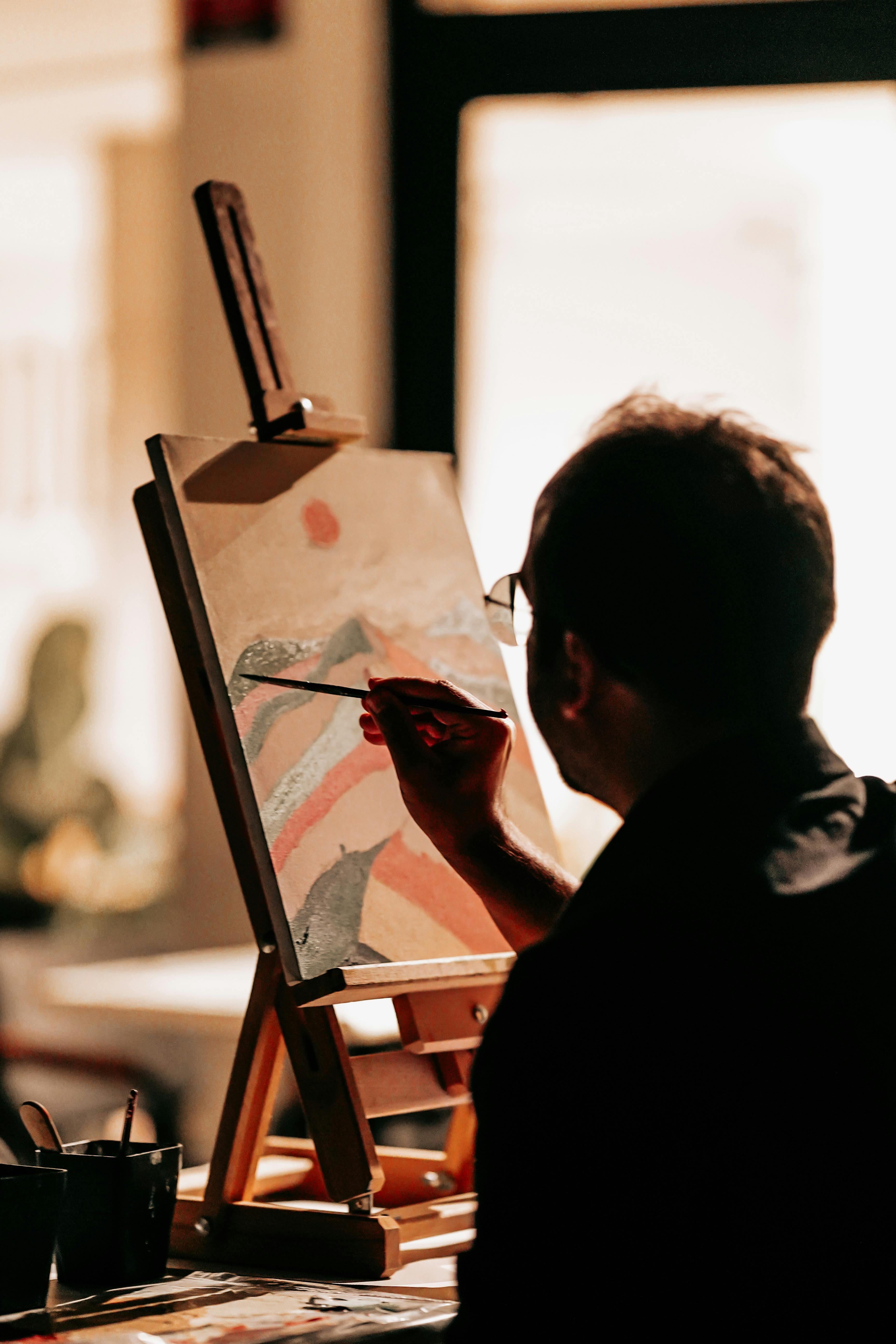
[credit](https://images.pexels.com/photos/18516626/pexels-photo-18516626/free-photo-of-man-painting-a-landscape.jpeg),
[licence](https://creativecommons.org/public-domain/)
#### Q: How often should I change my bedroom art?
A: This is entirely up to you and your personal preference! Some people love to rotate their art seasonally or whenever they refresh their decor, which can bring a renewed sense of energy to the room. Others prefer to find one perfect, timeless piece and keep it there for years. There's no right or wrong answer, but if a piece no longer brings you joy or feels right for your sanctuary, don't hesitate to change it.
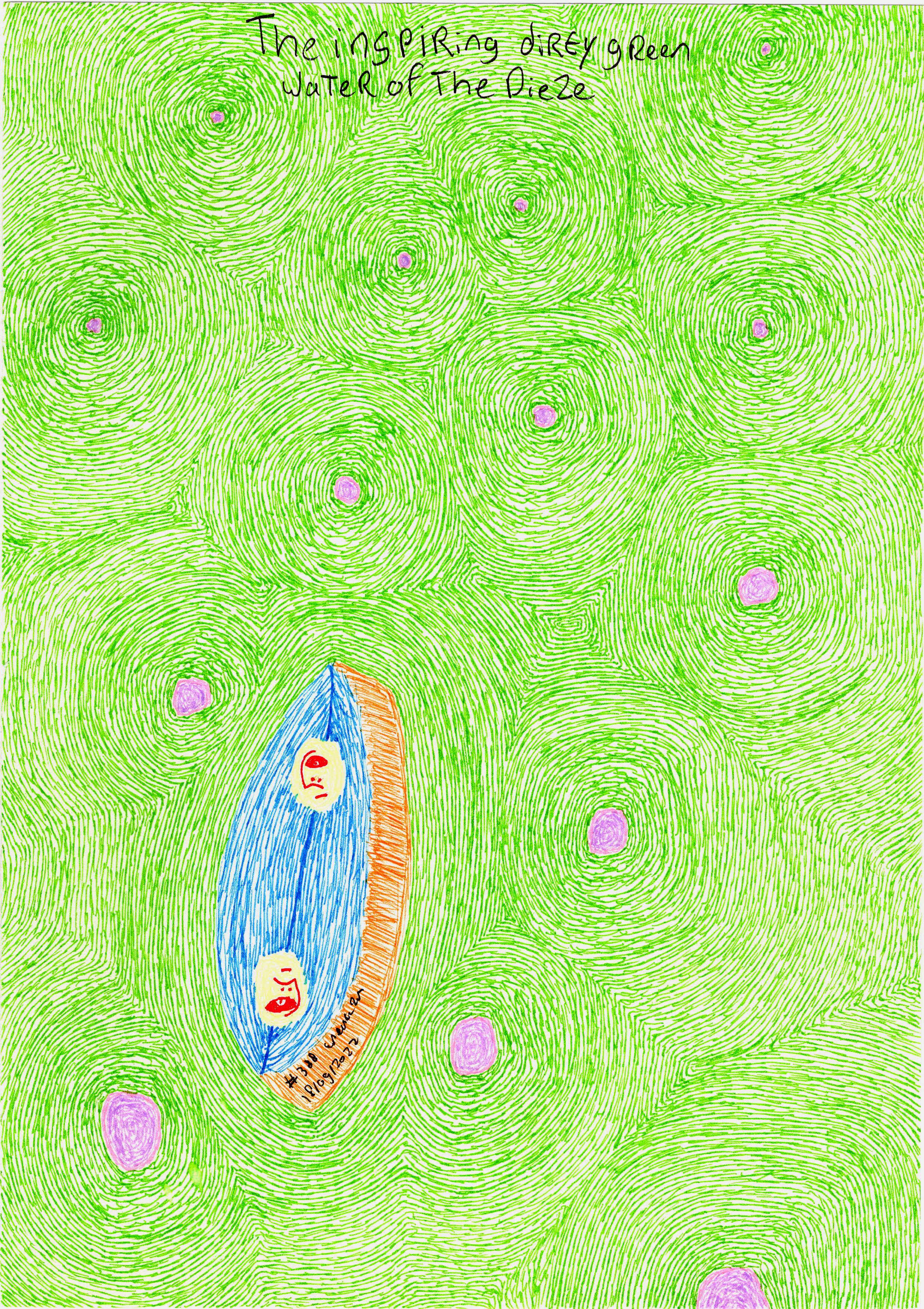
#### Q: How do I choose art that matches my bedroom decor?
A: Consider your existing color palette and overall style. Look for art that features complementary colors or a style that enhances the mood you want to create. For a minimalist room, choose art with clean lines; for a bohemian space, embrace texture. The art should feel like a natural extension of your room's aesthetic, not an afterthought.
### Your Bedroom, Your Canvas
Ultimately, the art above your bed is a deeply personal choice. It's an opportunity to infuse your most intimate space with beauty, calm, and a reflection of what makes you feel truly at home. Don't rush the process; let it be a journey of discovery, a mindful exploration of what truly resonates with your spirit. Find a piece that speaks to you, that makes you breathe a little easier, and that whispers "welcome home" every time you step into your sanctuary, helping you transition from the day's demands to peaceful slumber. This isn't just about decorating a wall; it's about crafting an environment that nurtures your well-being, supports your rest, and inspires quiet moments of introspection. It's about creating a dialogue between your outer space and your inner peace. May your bedroom be a canvas of calm, a haven of dreams, and a daily reminder of the beauty that surrounds you. And if you're ever looking for that special something, remember to explore the unique pieces I have available at [/buy](/buy) – perhaps your next bedroom masterpiece is waiting there to complete your personal haven! My hope is that your art becomes a quiet anchor, a source of profound peace, and a beautiful reflection of the deepest parts of you. It's an investment not just in decor, but in your daily well-being, fostering a deeper connection to your inner world and ensuring your bedroom is truly a space where you can thrive. Ultimately, this journey of choosing art for your bedroom is a profound act of self-care. It's about consciously shaping your environment to support your emotional and mental well-being, creating a space that recharges you for whatever the world demands. So take your time, trust your intuition, and let your bedroom art be a continuous source of serene inspiration.

[credit](https://commons.wikimedia.org/wiki/File:Screen_printing_at_NTAS.jpg),
[licence](https://creativecommons.org/licenses/by-sa/4.0)



